How Michael Bungay Stainer Sold 400K Copies of The Coaching Habit in Just 2 Years & Doubled Box of Crayons’ Revenue
Tune in to hear Michael share how his business model used to be “if it has a pulse and a wallet he was interested”, how they stay in the $3-5 million dollar profit margin range, and how good coaching can positively impact your business!

Time-Stamped Show Notes:
Resources From This Interview:
Leave Some Feedback:
Connect with Eric Siu:

This post originally appeared on Single Grain, a growth marketing agency focused on scaling customer acquisition.
As marketers, we know that there are a million things we could be working on at any given time: e-books, white papers, blog posts, webinars, paid advertising, e-mail marketing.
They’re all important, but part of running a successful business is about putting your focus on the highest-leverage activities. That’s the stuff that brings you the most bang for your buck — the stuff that helps you justify the ROI of your job to your boss.
One of the highest leverage activities you can spend your time on is optimizing your SEO. If you can get even one of your blog posts ranked at the top of Google for a broad keyword, it could drive thousands more visitors to your site every month.
And if you’ve got the rest of your sales funnel in place, then those thousands of visitors could add up to some significant ROI.
In this post, we’ll cover 20 tactics you can use to boost your SEO rankings.
The best, most efficient way to make your content stand out isn’t by reinventing the wheel — it’s by building a better version of what has already been proven to work.
Instead of trying to create an epic 10x piece of content from scratch, look for the blog posts or videos that already perform well within your niche and build on it. Brian Dean from Backlinko calls this the Skyscraper Technique.
For example, let’s say I wanted to write an article for a new marketing blog about Facebook ads.
First, I’d do some research to figure out which blog posts about Facebook ads have a track record of generating a lot of links. There are a few ways to do this.
I could go on Google, type in a broad search term, and see what ranks near the top.
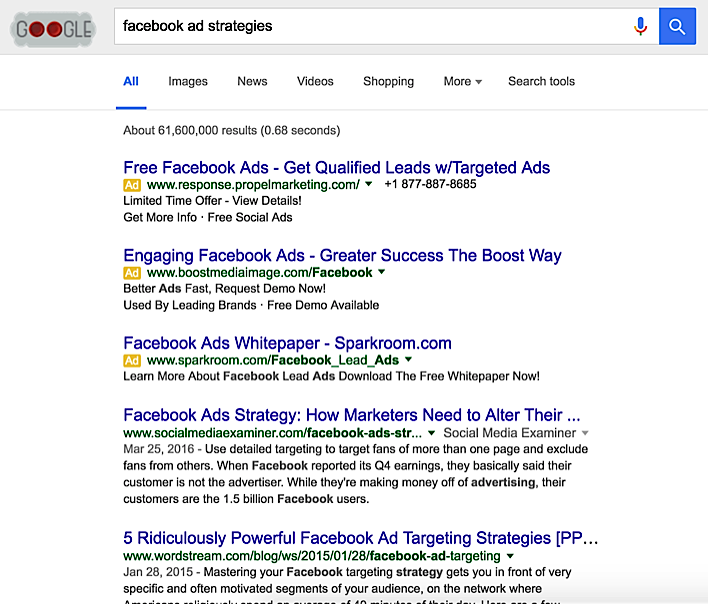
Or I could type a broad search term into a tool like BuzzSumo and immediately get a list of highly shared content related to my topic.
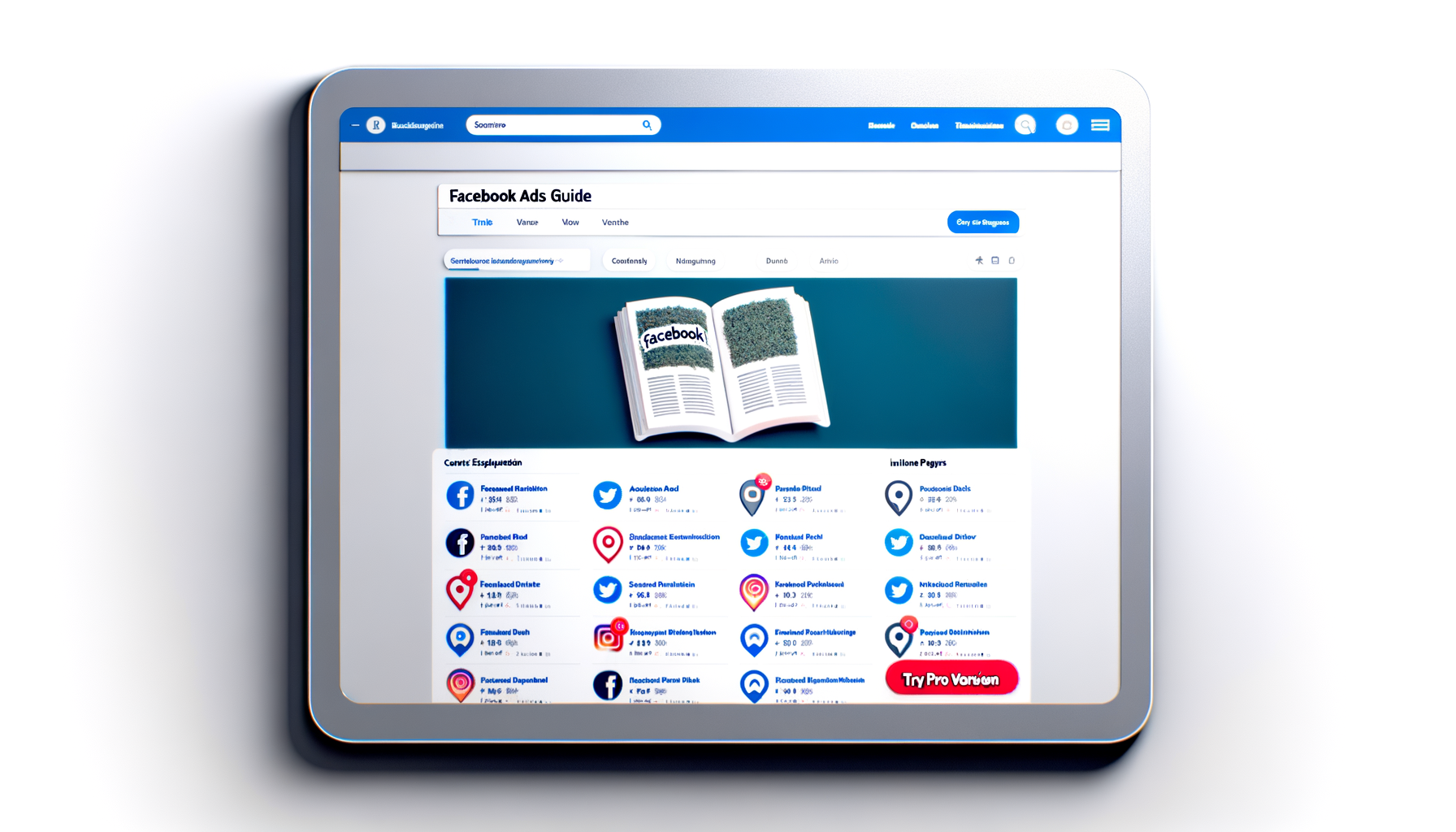
Next, I’d pick one of those successful pieces of content, and build on it.
One simple way to do this is just by making the post longer. For example, one of the top Google search results for “facebook ad strategies” is an article called “5 Ridiculously Powerful Ad Targeting Strategies.” To build on this idea, you might come up with something like “25 Facebook Ad Strategies to Grow Your Business.”
Another way to improve on existing content is by making it more visually appealing.
For example, this post on Pardot.com ranks at the top of Google for the search term “buyer journey,” mainly because of how the post is designed.
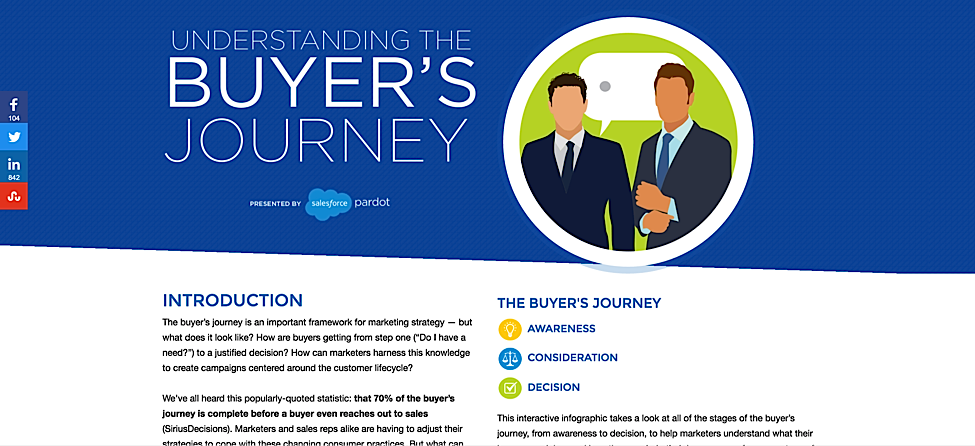
According to Brian Dean, by taking a post that is already proven and building on it, you drastically reduce the likelihood that your content falls flat because you’re writing content that has already worked.
An important factor for getting a post to rank high in the search results is having a lot of other influential people link back to it. One easy way to do this is by mentioning your industry’s influencers in your content.
When other people see their name mentioned somewhere on the Internet, they’re much more inclined to share the piece on their own social media, blogs or newsletters. And because industry influencers usually have large audiences, that means more targeted traffic back to your site.
For example, this entrepreneur curated an e-book full of the best Medium posts of 2015, and then sent it out to all the writers he mentioned within the e-book:
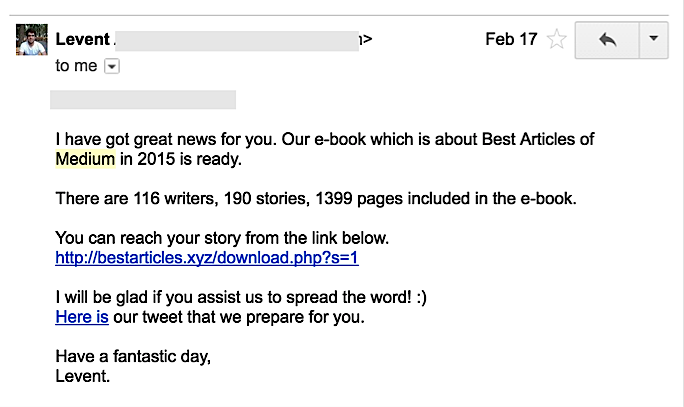
A simple e-mail like this sent to the right influencer could be the “tipping point” that makes your content go viral. In fact, according to Blogging Wizard, with the right approach you can get up to an 80% response rate from the top influencers in your industry.
We all have pages on our blog that perform really well in search, and others that fall on page three, four, or even lower. And the frustrating thing is that some of our low-ranked content may contain amazing material. If only those poor blog posts could get a little push — like a share from an influencer or several more backlinks — they might go viral or rank at the top of SERPs.
One way to give the poor-ranking content a push is by finding the posts on your site that rank higher in Google and adding links within them to the pages that rank lower.
For example, HubSpot ranks pretty high for the search term “content marketing strategy.”
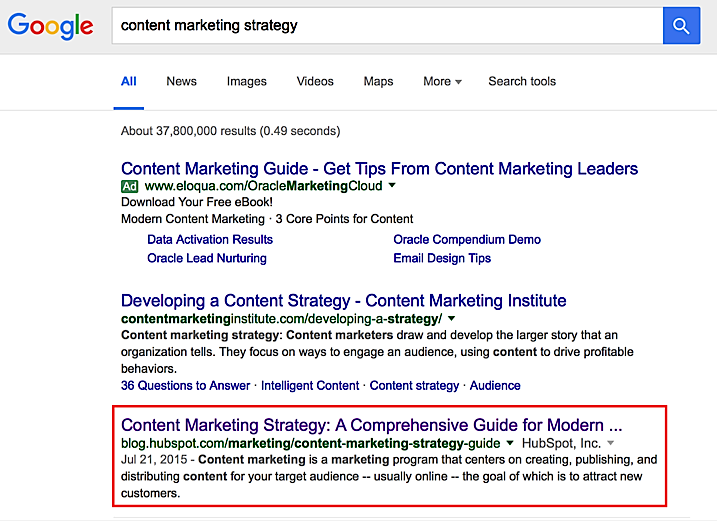
Within this post, they link to multiple articles on their blog about topics like list purchasing and developing a social media content calendar — neither of which rank as high.
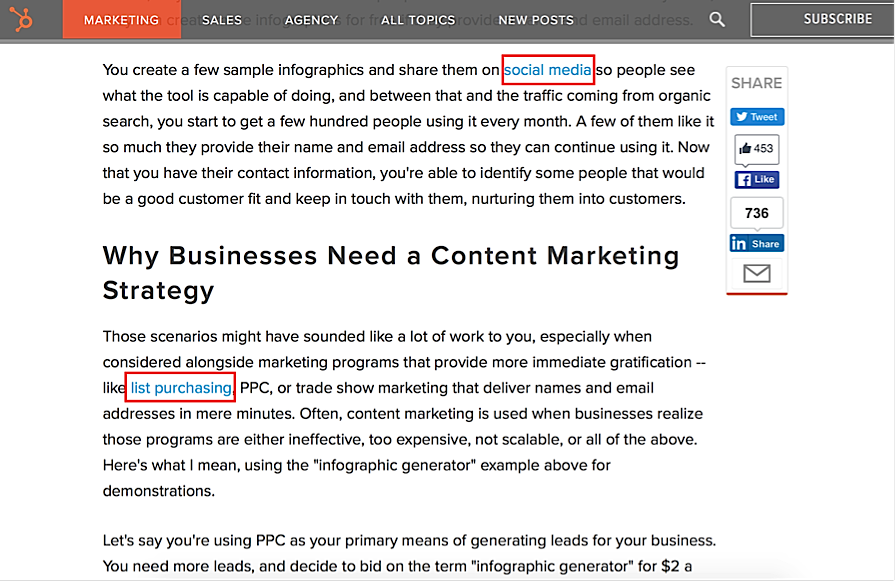
This is a great way to give some of your lower ranked content the boost they need to get to the top.
The best content is the kind that speaks to people’s emotions. Marketers who are able to connect with their audience can build a large audience of loyal readers relatively quickly.
Make sure you understand your market’s deepest hopes, fears and dreams around the subject about which you’re writing. Once you have a good grasp on this, you can weave it into your blog posts to show your audience that you really “get” them.
Steli Efti at Close.io, a SaaS product to help salespeople close more deals, does this really well.
Salespeople have a lot of hopes and fears around their job. For example, they might feel afraid of coming off as too “sleazy” or too fake.
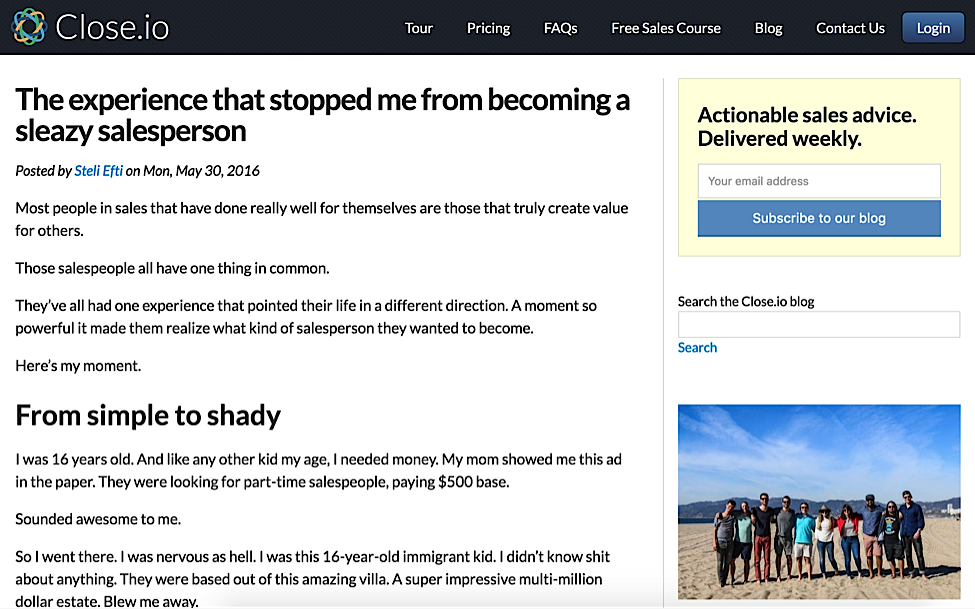
They might be afraid of hearing a bunch of “no” responses from leads.
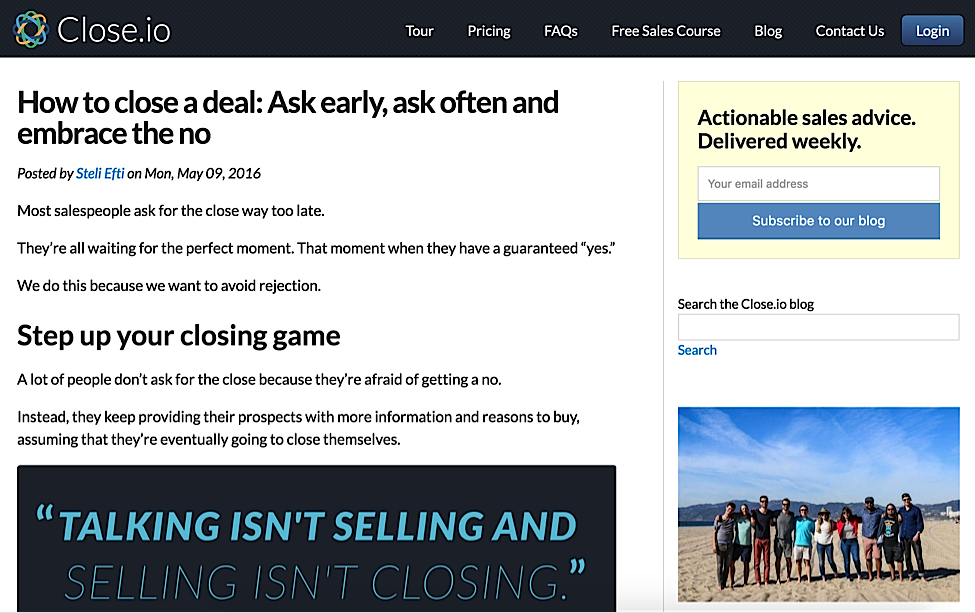
Or maybe they feel like they have no idea what they’re doing.
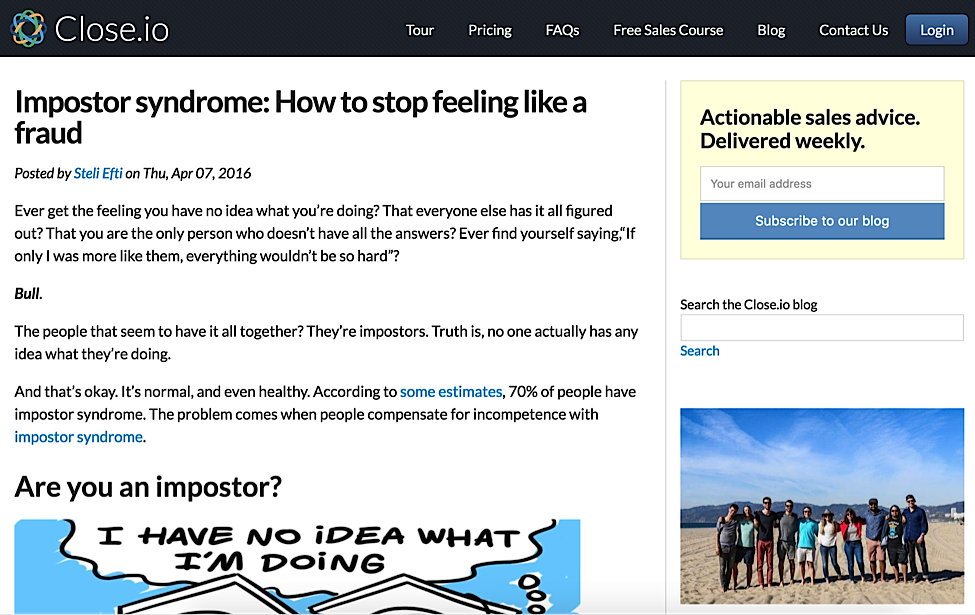
Because their content tells emotionally captivating stories that really “hit the spot” for their audience, Close.io’s blog has quickly become one of the go-to resources for salespeople.
Another great example is the Copy Hackers blog. Their content has a lot of personality infused into each post, which helps set the content apart from all the other marketing posts on the web.
Notice how friendly and fun this content sounds:
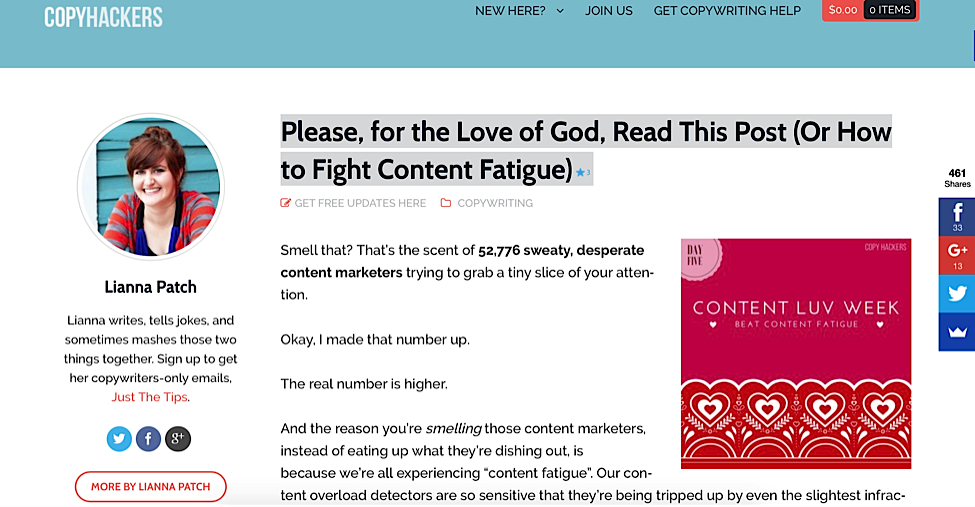
Businesses in virtually every industry can incorporate great storytelling and personality into their content if they understand their customers at a deep level. Even Pfizer was able to boost sales using this approach, according to this article by Cognitive Edge.
There are always a bunch of new SEO tactics popping up all the time, but at the end of the day, the best way to have your content reach more people is simply by writing stuff that they actually want to read! And one great way to do that is by writing posts that are fun and/or informative and appeal to the readers’ emotions.
Writing long-form content consistently takes a lot of effort. So before you start climbing that mountain, it’s important to ensure that you’re writing content for which people are actually searching.
One easy way to do this is by using the Keyword Planner on Google AdWords. It’s easy to see how many people are searching for a particular keyword, and you can even uncover related keywords to base your articles around.

Another great tool for gauging the number of search results for a particular topic is Google Trends, where you can uncover search trends over time for keywords to see if they’re worth pursuing.
Or you could use BuzzSumo to see the number of shares that certain types of content get and which keywords are getting a high rate of shares.
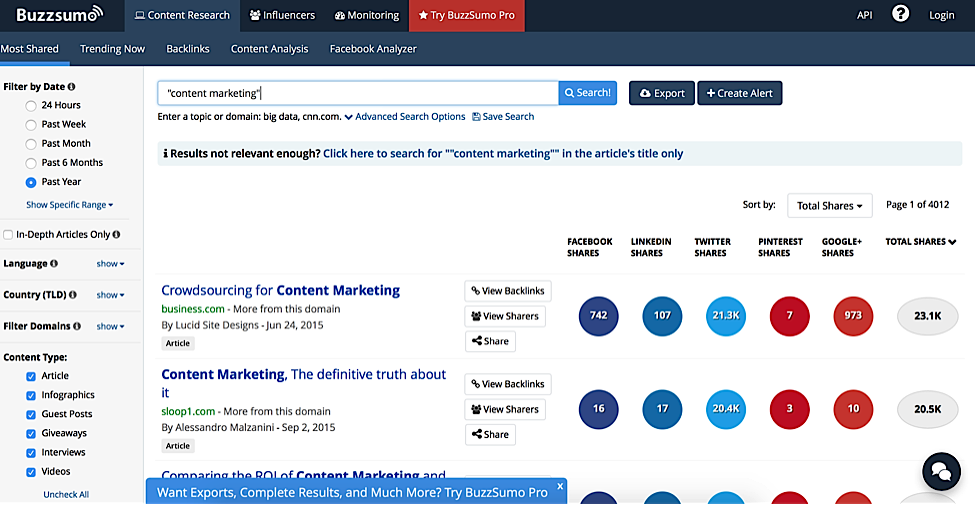
Moz has a great guide on how to do keyword research for SEO, including how to judge the value of a keyword and understanding how to use long tail keywords.
By creating remarkable, long-form content around keywords that have a high search volume, you make it easier for your blog posts to rank high for a topic and generate a lot of traffic to your website.
Broken link building is one of the most effective white hat strategies you can use to grow your SEO rankings.
The first step is to figure out which websites in your industry have broken links to your own site as well as your competitors’ sites. There are quite a few search term variations you can type into Google to uncover sites with dead links. According to this guide by Neil Patel and Brian Dean, here are some of them:
For example, you can type in “marketing + intitle:resources” to find posts that are filled with a bunch of links.
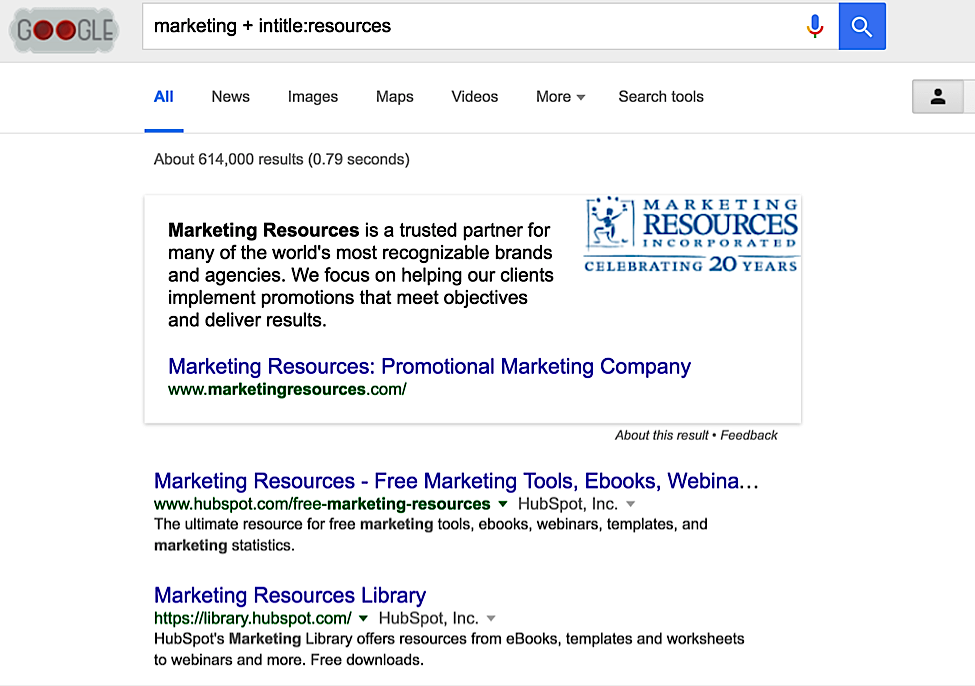
Next, you’ll have to scour the page to find the broken links. An easy way to do this is by downloading a Chrome plugin called Domain Hunter Plus, which scans pages for dead links.
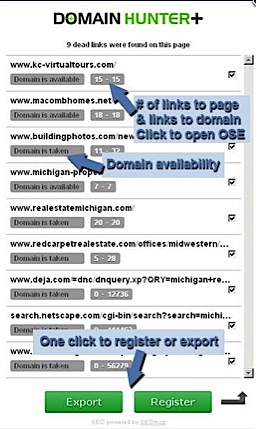
Once you activate the plugin for a particular page, you’ll get a list of dead links on that page. You can then export the list of links, send it to the site owner, and ask to replace the dead links with your own resources.
Relying on standalone blog posts to drive your SEO rankings is a losing battle.
A few individual pieces of content might appear high up on the search results, but there are better ways to get more mileage out of your blog posts. One tried-and-true way is the hub and spoke strategy.
Through this approach, you create one giant piece of content to function as the page that people land on directly from Google (your “hub”), and from that page, you link to a bunch of other relevant pages on your website (the “spokes”).
Your hub should be something that’s highly shareable, like a meaty post that people bookmark because of how informative it is and how many useful resources it contains. This way, your hub will rise in SEO rankings, and as a result your “spokes” will rise as well.
Copyblogger created a page called “Email Marketing: How to Push Send and Grow Your Business,” and within it, they’ve included supporting posts like “Why Vanity Metrics Are Worthless (and What Really Matters),” “37 Tips for Writing Emails that Get Opened, Read, and Clicked,” and more.
By creating a hub, or a “table of contents”-style guide around a topic in your niche that people can consistently refer to, you’re creating a larger piece of content that will rise higher and higher in search rankings.
And as a result, the content you link to within your hub will rise higher and higher as well.
As I mentioned earlier, mentioning industry influencers in your content is a great way to help your content get more shares.
And roundup posts are an efficient way to do this on a larger scale. In a roundup, you curate posts from experts in your niche and share them with your own readers. This tactic is an easy method to build relationships with the right people in your field, generate a bunch of traffic, and improve your SEO rankings.
According to Crazy Egg, these are a few key characteristics that make a high-quality roundup:
Once you’ve sourced a long list of high-quality links around a topic that your audience wants to know more about, you can ask each influencer to share the post with their own audience.
For example, here’s an e-mail that someone sent to me after including some of my content in a post:
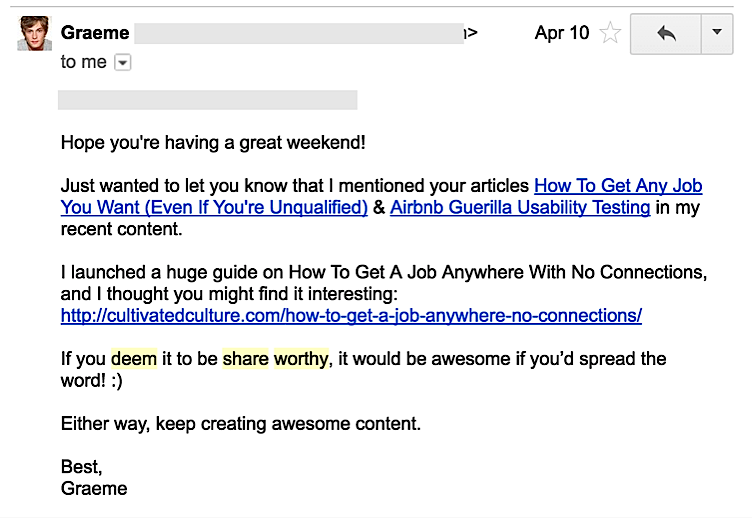
I ended up sharing it with my list of 20,000+ readers.
Long-tail keywords are keywords that are more specific and “narrow” than broader short tail keywords.
For example, “facebook advertising” is very broad search term, but “facebook advertising for SaaS companies” is much more specific.
It’s natural to create content focused on broad, short tail keywords. We think that because there are a lot of people searching for these more general phrases, we should take take advantage of that. But in reality, creating remarkable content that is focused on long-tail keywords can boost your conversions.
People want solutions that are tailored specifically for their situation. If you create a piece of content called “Facebook Advertising Strategies for B2B SaaS Companies,” you’d make B2B companies feel that you understand their specific situation a lot better than someone who wrote an article called “25 Facebook Ad Strategies to Grow Your Business.”
Even though you would be going after a smaller pie, you would dominate a much larger piece of it.
For more on how to identify and leverage long-tail keywords for SEO, see this guide: How to Identify Long Tail Keywords for Your SEO Campaign.
Whatever strategy you’re pursuing — whether it’s Facebook ads, SEO or anything else — the main point is to drive more prospects along the buyer’s journey to becoming customers.
That’s the main goal of content marketing.
SEO works best when it’s part of that larger content marketing strategy.
According to this guide by Salesforce Pardot (and this image from HubSpot), customers go through the following three stages before deciding to buy:
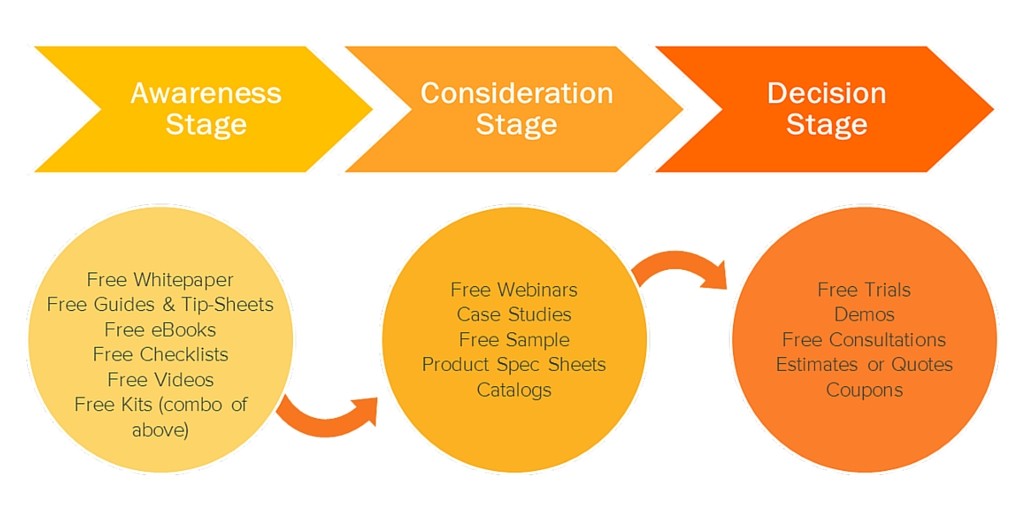
By creating high-quality content to serve customers at each step of the process, you’ll naturally rank higher in search results while also generating more sales.
Awareness Stage
At the awareness stage, customers are usually conscious that they have a problem, but they have no idea what the right solution looks like.
For example, if you’re selling services to help CEOs improve their content marketing, they might be thinking things like: “Ugh, I don’t want to waste hours and hours writing blog posts if I have no idea what the payoff is going to be” or “I need to outsource this but I don’t know how to figure out who’s the right person to handle it.”
At this stage, 72% of people immediately turn to Google to figure out how to solve their problems. They search for content that hits their specific pain points.
If you’re selling marketing services, a good piece of content to write might be something like “How to Speed Up Your Content Marketing Success.” This way, when customers search for their problem, your blog will be the first one they see.
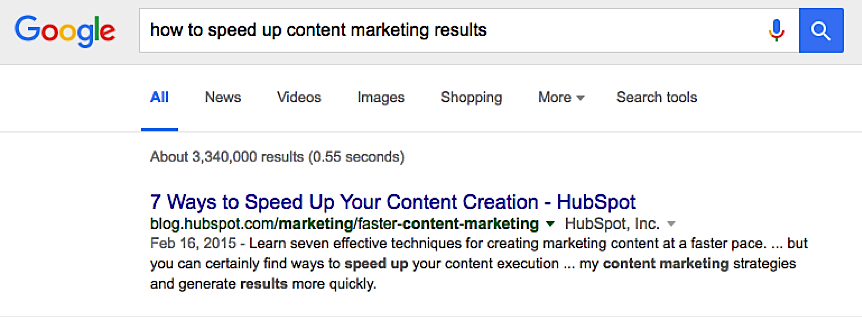
An example of how HubSpot attracts customers who are in the “awareness” stage.
Interest or Consideration Stage
As potential customers start to gather more information about their problem, they look for ways to solve it in the “interest” phase. At this stage, evidence-based content starts to become a lot more valuable to them.
According to Crystal Clear Communications, 30% of buyers consult white papers at this stage of the process, 29% consult case studies, and 30% of buyer influencers look to detailed technology guides.
Again, if you’re selling marketing services, good content at this stage might sound something like “The Ultimate Guide to Getting More Leads Through SEO.”
You can present these guides at the bottom of your blog posts and ask readers to fill out their e-mail address in order to receive them. This way, you help people transition from the “awareness” phase to the “interest” phase, and you capture their e-mail addresses so that you can send them more content down the road.
HubSpot does this well — when customers start off in the awareness phase searching for something like “how to speed up content marketing results,” HubSpot’s blog post is the first thing they see on Google:
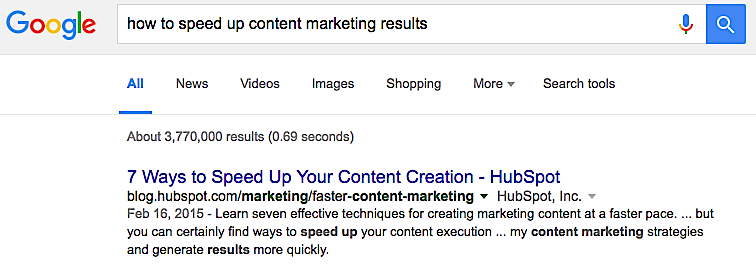
And at the bottom of that post, site visitors can sign up to get a free content strategy planning guide.
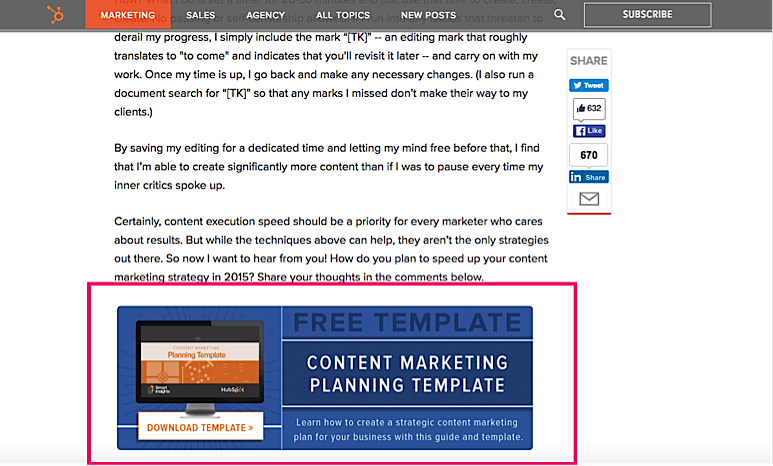
Evaluation or Decision Stage
Only after customers have done their research and figured out how to go about solving their problem are they ready to start thinking about purchase options in the “evaluation” phase.
At this stage, they’re trying to decide which service to buy. Good content here might be something like “4 Steps to Picking a Good Marketing Agency,” “Why Some Marketing Agencies Don’t Get Good Results” or something else along those lines. And in these posts, you can strategically position yourself against your competition by “teaching” your audience why you’re better.
Understanding what your customers are searching for at each step of the journey is super important — that way, you can create highly ranked content to help them along the way.
There are a few specific metrics that you can track to measure your overall SEO performance.
For example, one key metric for SEO is the average time that users spend on your content page. If your content is engaging, if it appeals to their emotions, if it’s useful, then readers will stay on the page longer in order to read more of your material. For more on the right metrics to track for your SEO, check out this post by Neil Patel: Quantify Your Results: The 14 Most Important Content Marketing Metrics.
If your website does not provide quality content, visitors will “bounce” off the page and “boomerang” to a competitor’s site.
Keep in mind that there’s no specific number here that can be considered “good” or “bad.” If you’re writing short-form content, for example, then you’re naturally going to have a low average time on your site. Or if you offer a great answer to a reader’s question, you might have a high bounce rate but also a high time on your site.
The number of return visitors is also a good metric to gauge how good your content is. How many readers come back to your site on a regular basis? If you’re sending e-mails to your subscription list regularly, how many people consistently open and click?
This is one of the most useful metrics that you can measure since return visitors are usually the most likely to convert to buyers.
There are a lot of benefits you can get from associating yourself with experts in your industry.
Read More: 5 Steps to Becoming an Expert Content Creator (According to Google’s Phantom Update)
One of the best ways to leverage that association is by interviewing these experts and repurposing the content into a blog post. That way, you can rank high for the expert’s name and siphon off a large audience that searches for them.
For example, Groove did an interview with Neil Patel and repurposed it into a blog post. Now when anyone searches “Neil Patel interview,” Groove shows up at the top of the results.

Venture Hacks did an interview with Sean Ellis, which also ranks at the top of Google for “sean ellis interview.”

By interviewing influencers in your industry and turning it into a blog post, you can attract a chunk of that influencer’s audience to your own site through Google search.
Part of maximizing the effectiveness of your content marketing is repurposing your material as much as you can.
As Neil Patel and Aaron Agius write in QuickSprout’s Complete Guide to Building Your Blog Audience, there are at least seven different ways to repurpose a single blog post. Turn it into a:
This could skyrocket the reach of each post that you write.
Let’s say you published a blog post called “How to Leverage Influencers in Your Content Marketing.” There are tons of different formats into which you can repurpose this content to attract a wider audience.
For starters, you could take that content and make it native for different blogging platforms like Quora, Medium or LinkedIn — which allow anyone to reach a targeted audience of tens of thousands of people if the content is good.
Then, using a tool like Visme, you can take that blog post and turn it into infographic.
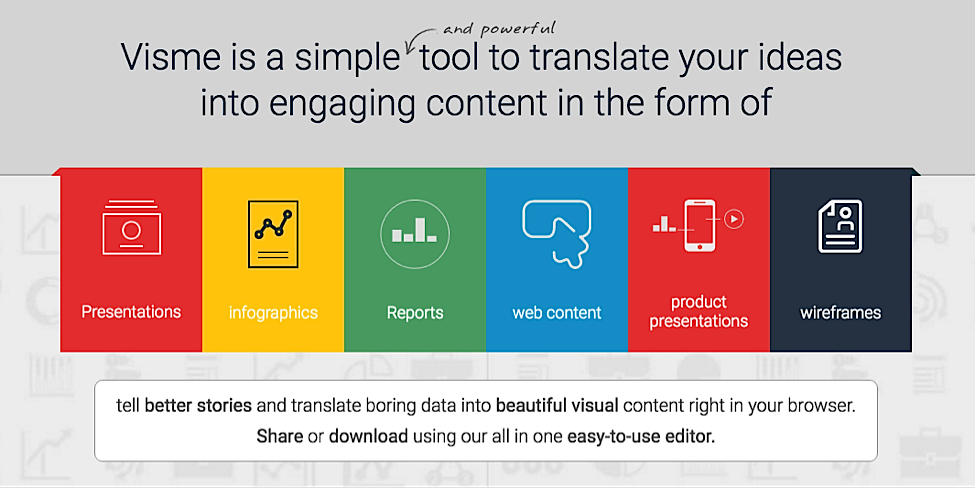
Noah Kagan found from analyzing 100 million articles that infographics get shared the most out of all types of content. This means that an infographic could potentially get more than double the reach of a single blog post, which makes it more likely to rank higher in search.

Then you could take the blog post and infographic and combine them into a compelling SlideShare presentation.
If you have a podcast, you could summarize the key points of the blog post in a quick 10-minute audio segment.
With a simple, structured system, you could skyrocket the reach of each piece of content you put out by making it “native” to several other platforms simultaneously, thereby increasing the likelihood that the content will rank high in SERPs.
A simple way to get more reach on your content is just to increase its length.
Longer-form posts are more comprehensive, get shared more frequently, and lead to lower bounce rates — which is why they tend to be ranked higher on Google.
According to serpIQ, average length of posts at the top positions on Google are 2450+ words.

Not only does this help with SEO, but more time spent on your page means you’d be cultivating more trust between you and your audience.
Content that’s visually appealing allows readers to digest a larger amount of information in a shorter period of time. It’s much easier to look at a graph or an infographic that’s well designed than a huge 5,000-word blog post — and as a result, it’s more likely to get shared.
You don’t need to be a design whiz to create content that’s visually appealing either. You could use a tool like Snapguide to create beautiful how-to guides, for example.
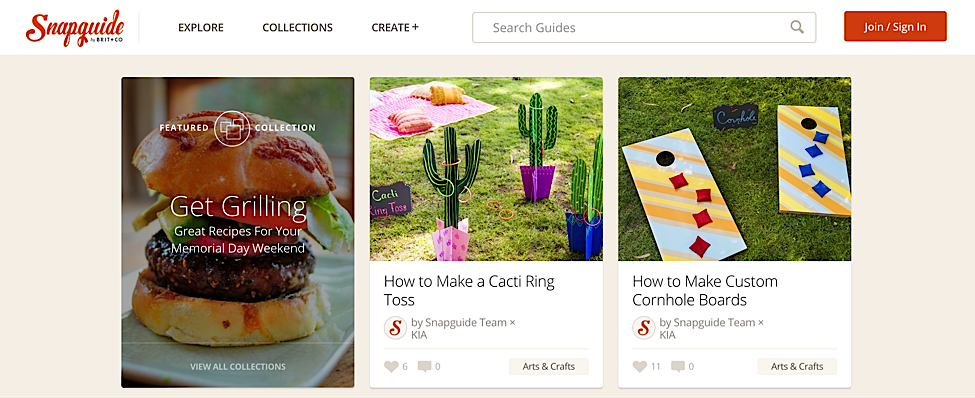
Written content is still very important, but the way the content is presented is also important. The more visual, the better.
According to Commonplaces Interactive, both Google and Bing have reported higher search traffic coming from mobile devices than computers.
That’s why these search engines boost content in search rankings that are mobile friendly.
If you’re not sure whether your site is mobile friendly or not, you can just insert the URL into Google’s Mobile Friendly site analyzer.
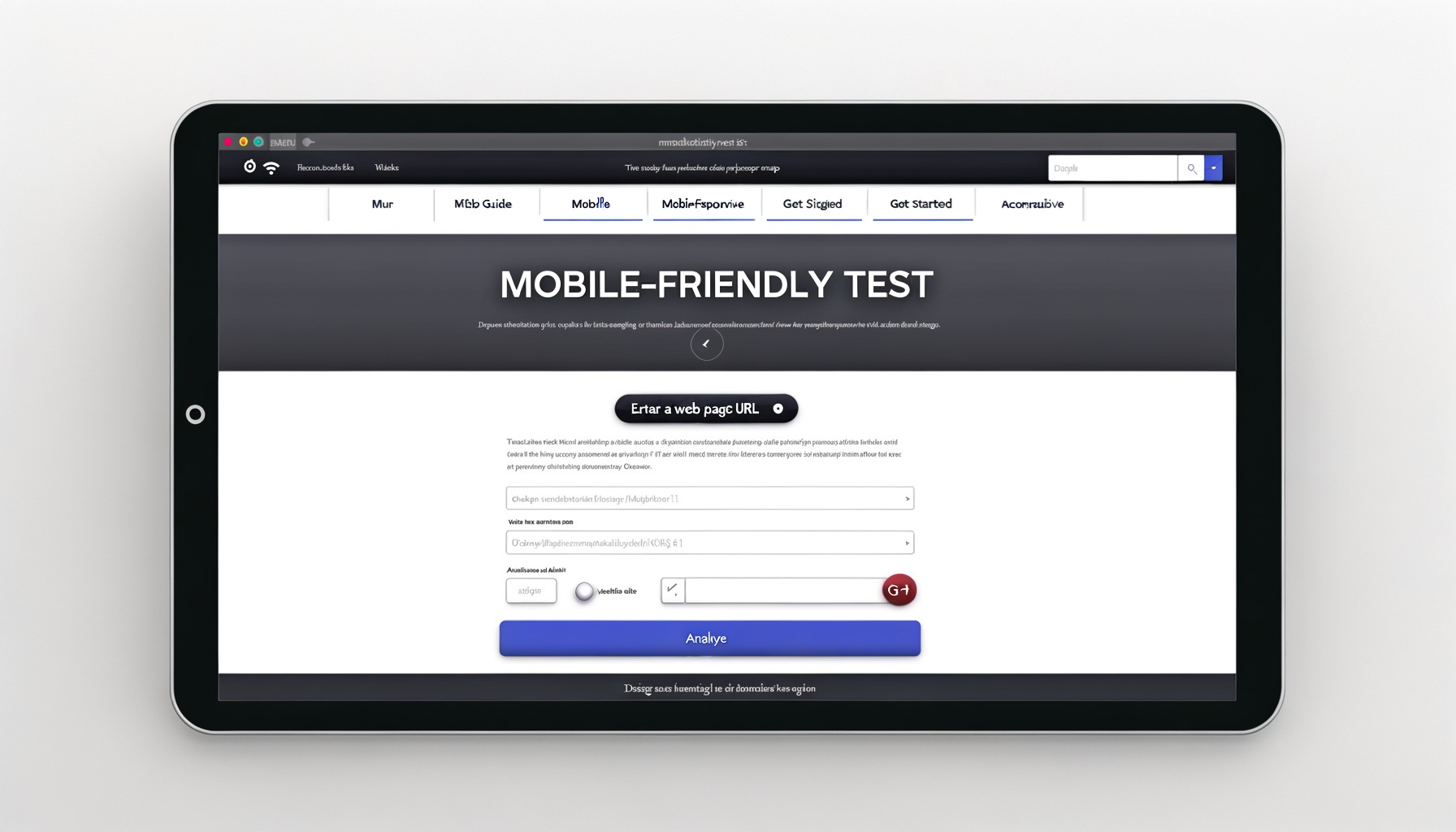
The easiest way to make sure that your site doesn’t get penalized in search results for this is by making it responsive. That way, it will “respond” to the device on which it’s being viewed, and won’t encounter any problems on any mobile devices.
By writing original blog posts on major media outlets, you can get a lot more exposure to your own site.
For example, Neil Patel wrote a guest post on Entrepreneur.com.
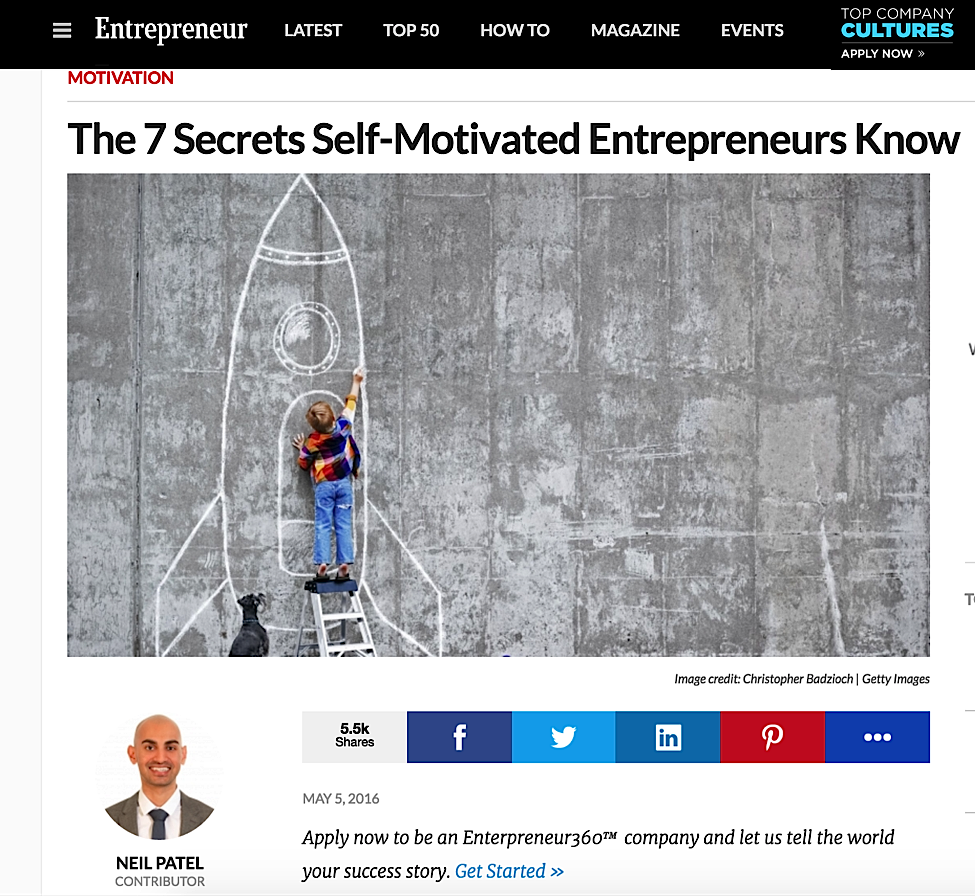
Within the post, he included multiple links back to his own blog, Quicksprout.
One thing you might want to be wary of is reposting content from your blog to a major media outlet. Although the exposure would be good, Google penalizes duplicate content in search results.
But writing original content for major sites could help build your credibility as well as get more backlinks to your blog. For more on this, check out How to Pitch a Guest Post to Editors at 104 Major Publications by Jon Morrow.
Another quick way to get more backlinks for your blog is by using a service called Help a Reporter Out (HARO). This site is aimed at the tons of journalists out there who are writing stories on various topics and need quotes from experts.
When you sign up for HARO, you’ll get notified every time a journalist who is writing about a topic in your field needs a quote. Then you can send in a quick pitch offering a quote along with your business name and website URL.
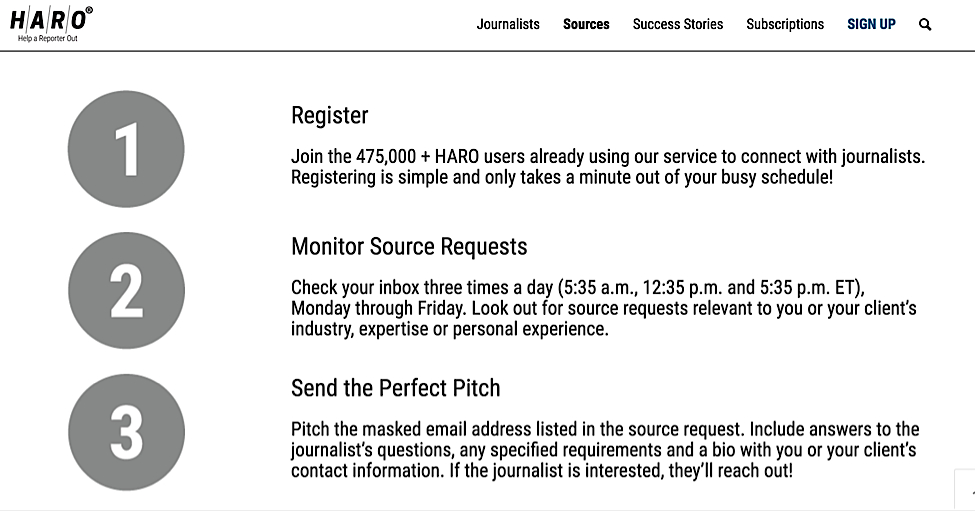
This is a great way to get your name and blog on a news media site without having to write a unique guest post.
If you deeply understand your audience’s emotional experience at each stage of the buyer’s journey, you can consistently create high-quality content that not only sits at the top of Google’s SERP, but also drives sales.
The best part is that it’s actually really easy to understand your audience’s emotional pain points.
All you have to do is set up an autoresponder message for everyone who signs up for your e-mail list. As soon as someone subscribes, you can send them something like this:
Hey [name],
I get hundreds of “marketing” e-mails everyday from random companies that are just a pain to sort through.
I want to be different. I want to send you e-mails that you actually look forward to reading.
So to make sure that I send you the best possible content, I wanted to ask you a quick question… What’s the #1 barrier that’s keeping you from [whatever success you’re trying to help them achieve]?
Just “hit reply” to this e-mail and let me know. I read every response.
Thank you,
[your name]
You’d be surprised at how many people pour out their life story in response to that, which helps you to know exactly what’s going through their mind.
It’s even better if you ask for feedback at each stage of the customer journey. Derek Halpern of Social Triggers asks non-buyers for feedback right after they make the decision not to buy from him:
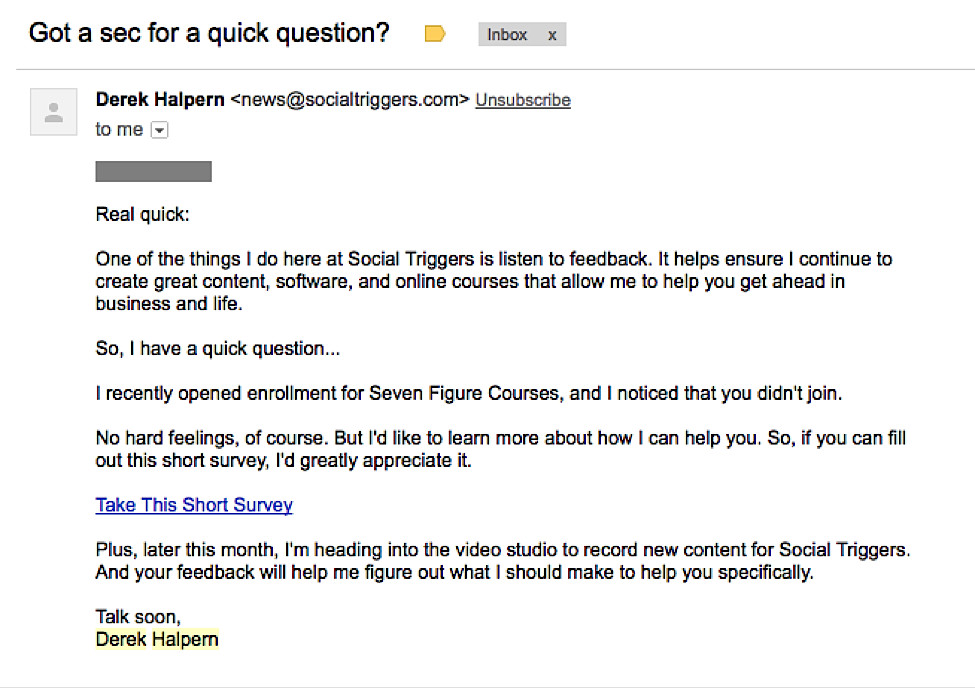
This way, you’ll know exactly how to create the right type of content that resonates at a deep level with your readers, gets shared, and ends up ranking high in the search pages.
This isn’t easy to do, but if you can do it, you’ll skyrocket the reach of your blog. People who invent terminology that catches on in their industry can really boost their SEO rankings.
For example, Brian Dean of Backlinko invented what he calls the Skyscraper Technique, which is a unique approach to creating content.
Now when anyone searches “skyscraper technique” on Google, his name is all over the web on multiple different sites.
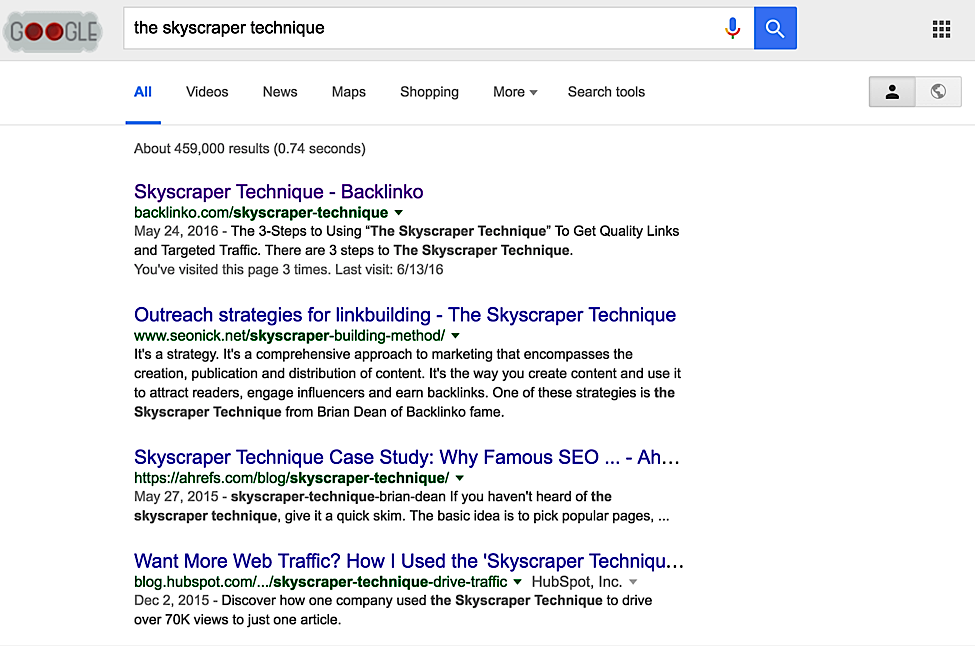
To invent your own term, you don’t need to create some crazy new breakthrough idea in your industry. All you need to do is take existing points of view that are already out there, “repackage” them, and make them your own.
For example, Tim Ferriss wasn’t the first ever lifestyle design blogger, but he was the first to package up his ideas into the “Four Hour Work Week.”
Gary Vaynerchuk isn’t the first to talk about understanding the context of social media platforms, but he was the first to position as “Jab Jab Jab Right Hook.”
So there you have it — 20 ways to boost your SEO rankings!
As marketers, there are a lot of tactics out there that we could potentially focus on. But those who get world-class results get them by focusing on high-leverage activities that deliver real long term results.
Now I want to hear from you. What other SEO tips would you recommend? Leave a comment below!
This podcast originally appeared on Marketing School, a podcast from Neil Patel and Eric Siu that brings you 10 minutes of actionable marketing advice every single day.
Marketing School: Where to Learn Marketing
Episode #1 – Eric and Neil introduce the world to The Marketing School—a daily podcast built to share marketing insights with the world. Today’s main topic: where you can go to learn marketing.
Show Notes:
3 Key Points:
Resources Mentioned:
Leave some feedback:
Connect with us:

How do you get smarter?
Simple—you ingest as much information as you can and parse out the information that really resonates with you. Warren Buffett spends over 5 hours reading each day just so he can keep up with the important events happening around him.
People often talk about reading books, listening to audiobooks/podcasts, going to conferences and reading blog posts. How about newsletters?
Although numbers show that e-mail is starting to die, it’s still a highly engaging channel. It’s still one of the best ways to drive revenues online. So engaging in fact, that for every $1 spent on e-mail marketing, the average return is $44.25.
E-mail engagement has been decreasing over the years. Just take a look at this image from Bear and Beam:

The most important thing is getting the right information in front of you since so many e-mail newsletters are just an abundance of promotional spam.
But if you can get it right, the information flowing to you will be an invaluable addition to your content consumption schedule. If one of the richest men in the world can make time to read 5+ hours a day, I’m sure you can block out some time to as well.
I tend to skip a lot of e-mail newsletters, but there are a select few that I hold dear to my heart because I LEARN a lot from them. The newsletters I subscribe to cover the following:
If you’re an entrepreneur (or aspiring entrepreneur), it’ll be beneficial for you to check at least one of these out. Venture capital is always interesting to me because it points to where capital is flowing for ‘the next big thing’.
Without further ado, I’m pleased to share my favorite newsletters (in no particular order):
Investor and Digg founder Kevin Rose curates a monthly newsletter with his latest ramblings. He shares favorite products he likes, how-to’s that he finds useful, his favorite TED talks, interesting topics (e.g. fasting, ice baths, etc.), and more.

You can sign up for it here <==
Tim Ferriss’ weekly newsletter gives you a peek into the world of the best-selling author. He’ll recommend books, something he really enjoyed reading that week, interesting quotes, and a recent purchase.

You can sign up for it here <==
This is by far my most favorite venture capital newsletter for the week. It’s PACKED with information on things that I typically don’t think about (e.g. emerging layers, world diseases, how the world is running out of groundwater, and more).
There are a lot of things in this world that you don’t know you don’t know. But when you start to move things to the territory of ‘know you don’t know’, you can start to take control and go deeper down the rabbit hole on subjects that you’re truly interested in. If you haven’t seen my interview with Social Capital Partner Mamoon Hamid, go listen to it now. You’ll enjoy it!

You can sign up for it here <==
KISSmetrics and Crazy Egg co-founder Hiten Shah is someone I consider to be a mentor figure who’s always consuming and sharing interesting knowledge. Just follow his Twitter or Facebook and you’ll find that to be the case. Luckily, he also curates a weekly digest of his favorite readings which is even more valuable because he’s spent the time to distill what really resonated with him. You can listen to my interview with him here.

You can sign up for it here <==
Echosign (sold to Adobe) co-founder and SaaS godfather Jason Lemkin knows a thing or two when it comes to software-as-a-service (Saas). In fact, he throws one of the best conferences in San Francisco each year called the SaaStr annual.
For people building a software subscription business, this is a must-have. In fact, you should also add his Quora posts to your list of reading material because it’s damn good. So good, in fact, that he has crossed well over 10 million views. If you haven’t checked out my action-packed interview with him, you can listen in right here.

You can sign up for it here <==
The Mattermark Daily is a hand-curated newsletter compiled daily to bring you first-person accounts of entrepreneurship, investment, and insights from the startup ecosystem. I enjoy the weekly digest the most because it features the top 10 posts. You’ll learn about topics such as fundraising, first-time founder lessons, convertible debt, and more.

You can sign up for it here <==
How many of you get confused by the world of finance? I certainly do. What if I told you there was a newsletter that condenses important financial news and makes it understandable to a 5th grader? Well, maybe not that simple, but you get the point that I’m trying to make.
I think it’s important to understand what’s going on in the financial markets but when I don’t have a strong understanding of the vernacular, it makes my eyes just glaze over. Finimize calls itself ‘pocket-sized financial news’ and it’s exactly that. Each tidbit of news is broken down into sections:

You can sign up for it here <==
CBInsights’ digest is another great newsletter that talks about emerging industries, venture capital, and disruptive startups. There’s more of a flair/attitude to this newsletter because they aren’t afraid to speak their mind. If they think something sucks, they’ll tell you upfront.
As with a lot of venture capital newsletter, it’s LOADED with data. In fact, content marketing has consistently been one of their top growth drivers for the past few years. You can listen to my interview with CEO Anand Sanwal on how he gets $1,000+ signups per month using content marketing.

You can sign up for it here <==
Growth Hackers is a marketing community where people share growth strategies and tactics. Top posts are upvoted by the community to make it easier to find the “best of the best” content. Topics on growth hacking include growth case studies, AMA with marketing executives, advertising, SEO, and more.

To get access, simply sign up to be a member of Growth Hackers.
HubSpot co-founder Dharmesh Shah and Moz co-founder Rand Fishkin teamed up a few years ago to create an inbound marketing community. Inbound.org is similar to Growth Hackers in the sense that the best posts are pushed to the top via upvotes from members of the community. Topics you’ll typically see will center around SEO, conversion rate optimization, copywriting, and more. They also have great discussions on the forum itself.

To get access, simply sign up to be a member of Inbound.org.
In today’s age where 2.7 million blog posts are published each day, it’s hard to tell signal from noise. But when you’re able to fine tune your radar and truly hone in on information that matters to you, you’ve struck gold. From there, you’ll be able to quickly parse out the most relevant information and take action that will make an impact on your life.
How many newsletters do you subscribe to? What are some of your favorites?
The Strategy That Skyrocketed Hotjar to $1 Million ARR in 6 Months

Hi everyone! Today’s interview is with David Darmanin, CEO of Hotjar, a powerful tool that allows you to see how visitors are really using your website, collect user feedback, and turn more visitors into customers.
Today we’re talking about this great all-in-one analytics tool and how they’ve grown rapidly via both paid and unpaid advertising, how they’ve increased retention over time by building new features, and why finding the right people for your team early on is so important.
A Passion For Creating
David always had a passion for creating visual stuff which, back in the day, was flyers (and later web design), and he was determined to understand what made a design good (or bad). Eventually he became a consultant who worked for big clients, but he wasn’t happy using the tools that were available, wasn’t happy with how they worked or how they were priced. So he reached out to some of the talented people he had worked with before and they got together and basically changed the way this industry works—which is the industry of how a website is being used and what your users think about it.
Hotjar Is an Easy Way to Truly Understand Your Web and Mobile Site Visitors
While Google Analytics shows you where your visitors are going on your site, Hotjar actually shows you what they’re doing and what they think. It shows heat maps and aggregate visualization—like where your visitors are clicking, how they’re moving their mouse, how much they’re scrolling—and you can even record and replay a whole session. They’ve even made it possible to get feedback, so you can ask questions, do surveys, or recruit people to join you on a user test.
In summary, Hotjar is an all-in-one analytics and feedback tool.
80,000 Customers and $1M in ARR in 6 Months—Clearly They’re Doing Something Right
Hotjar is a free tool, so even though they have customers on higher-tier plans, their vision is to change the way the web is built and improved. As such, one big metric for them is how many people are actually using the tool.
They have 80,000 subscribed users and out of that they have about 6,000 paid organizations—and this number is growing quite quickly. This is not something they optimize against, but obviously their customers are important, so they make sure that their users are getting the most value out of Hotjar. After all, having satisfied customers is the best way to grow.
David says they were lucky that after a 7-month initial beta program, within 4-6 weeks they were already covering all their operation costs because they had so many users who were willing to pay to continue using it, and within 6 months they hit $1M in ARR (Annual Run Rates).
So the real core of why they managed to succeed, after David had already failed at two previous projects, is that they focused on solving a problem that many people have. They approached the business in a very lean way; by kicking off with a 7-month beta program, it was very easy to grow, spread the word, get people using it, get feedback, and make sure they built a kickass product.
Get Fans to Spread the Word by Giving Them a Great Product
If you’re building a product or running a business, you can’t force people to spread the word, so the key is to build a product that generates that type of enthusiasm. Then you can do a lot to incentivize it and make it easy for fans to spread the word for you. During their beta run, they gamified the idea of getting access to Hotjar by having a queue system where the more you share the higher up you go and the earlier you get access.
They were disrupting an industry where most companies are charging high prices and investing in their sales team, so David made sure to tell their users during the beta program, “Helping us spread the word is the fastest way to make this product accessible for yourselves.”
Acquiring Those First 1,000 Customers
David and the other founders put a lot of effort into speaking to sites that cover beta programs, sent out email blasts to their communities, got really good coverage twice on Product Hunt, and had a lot of bloggers talking about Hotjar. And then, to add fuel to the fire, they also did some paid stuff, like Facebook targeting to typical users. So even though some of this was paid, it was not advertising so much as facilitating and accelerating the spreading of the news.
Increasing Retention By Building New Features
With tools like Crazy Egg, many people find that once they’ve got the heat map they don’t really need to keep using, so they get what they want, cancel, and possibly come back later. This also happens with Hotjar, so they’ve focused on building a product where you can upgrade or downgrade whenever you want, since there’s no yearly requirement.
Flexibility is really important for long-term relationships with their customers. From a business point of view, of course, there are gains to keeping customers as long as possible, so to that end they’ve got some exciting new updates in the pipeline (which they’ve developed as a result of feedback from their users), such as new functionality for day-to-day use, like event tracking or continuous inbound feedback.
One Big Struggle They Faced While Growing the Business
One of the biggest challenges they faced was finding the right people early on, which can be very difficult for a small startup. It’s very easy and tempting, especially when you’re building something that is gaining visibility and momentum, to quickly bring on board those people who reach out to you because it seems like a good opportunity. But it’s really important to define a long-term vision and a roadmap and then plot out who you need in terms of roles and responsibilities. That way you avoid just going with the first choice that comes along. And if you don’t find the right person right away, you must patiently wait until you do.
People will advise you to employ your friends, which can be good if you’ve already worked with them in the past, but only if they fit into the role you’ve defined. Don’t take shortcuts because it can be much more painful later on. So just as you build demand for your product, you have to be thinking about how to build demand so that the right people will be attracted to working for you.
Finding the Right People & the Right Tools for Hotjar
Because Hotjar is a remote business, it can be tricky to bring someone on who doesn’t have remote experience. So they advertise on sites like We Work Remotely or Stack Overflow, as well as leveraging their 80,000-user base by asking them if they know of anyone relevant when a new position opens up.
The most indispensable tools they use at Hotjar to work remotely are HipChat (Slack is a great alternative), where you can create separate channels for different topics or quickly communicate directly with individual team members, and Hangouts to launch calls and use the calendar. And they run the whole company on Google Apps.
These are the HipChat channels they’ve created:
What Their Remote Working Environment Looks Like
David finds that the key around culture in a remote company is to have the right tools in order to leverage very transparent communication, which doesn’t need to be over-complicated, but you do need a good structure. It’s important to focus on documentation and process because when you’re not there personally, the processes become much more important.
So the key for them has been to have everything built around a predictable and structured weekly basis. For example:
Advice To His 25-Year-Old Self
He would definitely tell his younger self to focus much more on the user than on the business. At 25 he was already building and growing businesses, and he wishes that he knew back then what he knows now, which is: if you center your strategy around value for the user—what they think and feel, and what their problems and needs are—you’ll be much more successful at a faster rate.
His Daily Structure:
One Must-Read Book
It’s always hard to choose just one book that’s had an impact on his life, so David gives us two:
Resources from this interview:
Leave some feedback:
Connect with Eric Siu:
Why Neil Patel Pays $30,000 for Content & Gives it Away for Free (& MUCH More)

Today I’m talking to Neil Patel, one of my mentors who’s ran many successful companies and is a rock star of the internet marketing world.
We tried to avoid the typical questions he gets asked during interviews, and instead dive deeper into topics like mentoring, business partnerships, and what it was like to be in the trenches of a startup no one wanted to fund, but turned into a huge success.
A Young, Naive Entrepreneur Learns Internet Traffic Isn’t Easy to Come By
At just 16 years old, Neil knew he wanted to be an entrepreneur. He started a job board website that was an exact, yet terrible, replica of Monster.com.
He said there were no job postings or companies willing to pay for job postings. He realized he needed traffic to his site, so he hired a few internet marketing firms to do the work. They took his money, but didn’t drive any traffic.
Since he was just a kid with a minimum-wage job who couldn’t afford to keep throwing money at marketing firms, he didn’t have any other choice but to learn how to do marketing on his own.
“I got into the business I am right now because I thought when you put up a website, people just come to the website, and it magically becomes popular,” he said.
He became an internet marketing expert, and then got into making software for internet marketing because he realized consulting wasn’t scalable.
Why He Stopped Consulting But Still Does Speaking Engagements
Consulting isn’t scalable, and neither is speaking, but Neil still takes on speaking engagements for purposes other than the events and conferences in and of themselves.
Rather than speaking in the US, he prefers to speak overseas so he can know and understand different cultures and how they do business.
Even though the US has a high GDP, the majority of the population is elsewhere and other countries are developing at a quick pace. By getting to know other people and learning their cultures, it helps him expand his businesses into new territories when the time comes.
For example, in a recent trip to Tel Aviv, he learned what a great location it is to set up a sales office.
Because the labor is inexpensive, there’s a hard-working and competitive culture, and there’s immigrants there from all over, you can effectively target most of Europe via Tel Aviv at 1/4 the cost of having a sales office in the US.
Other Ways for Entrepreneurs to Learn from the World Around Them: Local Events
Neil suggests for entrepreneurs to go to networking events, local meet ups and conferences as the quickest place to get feedback on their ideas and their product development.
“I think knowledge is the one thing in this world that is really priceless,” he says. “The more I learn, the better off my businesses are going to do.”
As an example, Neil said he loves going to healthcare and financial events because those entrepreneurs think differently than the tech-based startup ecosystem, and getting different perspectives that can be leveraged in a startup can be very valuable.
What He’s Learned as a Business Advisor: Why Startups Fail
By sitting on different boards, Neil sites two key problems entrepreneurs have when it comes to growth:
Helping as a Mentor: Why He Wanted to Help Eric
“You were aggressive, in which you just kept pestering me and I don’t mean that in a bad way,” said Neil to Eric. “Pestering is probably a bad word. You were persistent.”
In the course of time that led up to Neil deciding to take Eric on as a mentee, Eric was constantly messaging Neil with short, to-the-point emails that contained sophisticated, non-basic questions – asking just one question at a time, making it easier for Neil to reply.
After getting to know him a bit through email exchanges, Neil saw potential in Eric so he decided to help him out and took things a little further by suggesting they do a 30 minute call together.
He said he was willing to give up some of his free time, because deciding what to do with your free time (whether helping someone or watching a TV show), has an effect on your future. Because he saw the potential, he knew it might not pay off immediately, but they may be able to work together and turn a profit in two to three years.
The key takeaway to getting a mentor, says Neil, is to be persistent, but to also try to be equal.
At the same time that Eric was asking him questions to help his business, he was also trying to help Neil’s. For example, he gave Neil suggestions on ads by comparing his ads to someone else’s and showing him the statistics.
Even though he didn’t take much of Eric’s help in the beginning, he did appreciate it.
High-Level Content Production on Quick Sprout
Neil says reaching a high level of content production is all about streamlining the process from coming up with topics, outlining them, and cranking them out. He suggests two posts he’s written on Quick Sprout about coming up with ideas and quickly creating powerful content (see resources below).
“You’ve got to go above and beyond,” says Neil. “So much that no one’s willing to copy you.”
As an example, he creates guides to educate his audience that take a ridiculous amount of design time, making the content far too time-consuming to replicate. Banking on your own hard work and other peoples’ laziness is one way to differentiate yourself to get a fair amount of traffic.
With his streamlined process, he’s able to put out 30,000 to 40,000 word guides within just two months: While it’s being written, there’s someone taking care of the proofreading, then that chapter gets sent to design while the next one is being written.
In all, he spends around $30,000 just to complete one of these guides.
So… Why Does He Give $30,000 Guides Away for Free?
“It’s a marketing experiment, right?” he says. “I like learning and the quickest way I learn is by spending money.”
“Some of it’s also ego as well,” he goes on. “I do want to brand myself as a great marketer.”
Giving all this great content away for free is a sure-fire way for him to brand himself as a top internet marketing mastermind.
And, Why Exactly Does He Help People So Much?
Neil credits the success he has today to his early mentors who helped him out without expecting anything in return.
He wasn’t expecting their help, but the men who helped him were solid entrepreneurs.
So today, when Neil does mentoring or decides to help people, he doesn’t want anything for himself, he just wants to see other people succeed in the same way these men did for him.
The Batman & Robin Partnership: Neil Patel & Hiten Shah
Neil and Hiten met when they were both pretty young… and when Hiten married Neil’s sister.
In the beginning, they weren’t thinking about doing long-term business together, but they were both finding ways to grow and doing whatever they could to make more money.
Neil had a technical background and saw that Hiten was smart, studying business at UC Berkley. So they made the partnership.
Over the years, they’ve gotten to know each other’s work patterns and mindsets really well, to the point that it’s actually far more efficient for them to stay together as partners because their goals are very aligned.
But giving credit where credit is due, Neil says the success of the partnership has a lot to do with his sister acting as a go-between, giving hints to one when the other needs help with certain things.
“She’s actually the glue of our business partnership,” says Neil. He even cited an example of her working from the hospital while giving birth doing support emails for Crazy Egg. A lot of their work would not be possible without her.
The Work & Email Productivity Balance
Since both Neil and Hiten are both really great at responding to people via email, we were curious about what Neil had to say on this subject, since so many people swear off having their inbox open to boost their productivity.
“My whole workday is within my email,” said Neil. Elon Musk spends most of his time in emails, too.
The trick is not letting your emails sit around.
“When you open up your email,” advises Neil, “respond to it right away – don’t mark it and respond to it later. It creates inefficiencies and you’ll spend double to triple time on email.”
That Time When a Lawsuit Landed KISSmetrics in a Downward Spiral
At one point, KISSmetrics was in a lawsuit and at the center of an FTC investigation. (There were no problems, but the investigation came about due to bad press about privacy and had to be conducted.)
This cost Neil and Hiten a lot of money, their client list suffered, and they found themselves in a position where they needed to raise more money because they were getting really close to profitability before the lawsuit hit.
Unfortunately, no VC wants to provide funding to the company that’s in the middle of a lawsuit and and FTC investigation simultaneously.
Luckily for them, they had True Ventures, a good VC that knew them well and has always had their back.
But even though they found some cash to help pull them through, they still had to find ways to cut costs.
Because they needed to expand sales due to their lost customer base, their product suffered, they had downtime, and companies were complaining. They were in the middle of cutting costs when they started getting more customers, which overloaded their systems, so things started hanging and it became even harder to improve their product.
With a venture-backed startup, says Neil, there’s more stress to get it right and grow quickly than their is with a self-funded startup like Crazy Egg.
Fortunately though, they pulled through the fiasco and KISSmetrics is alive and well.
Hard Lessons Learned from an Instagram Press Project
At one point, a lot of Neil’s older, wealthy entrepreneur friends were telling him about Dan Bilzarian’s Instagram account and how they liked living vicariously through him.
He didn’t exactly want to replicate what Dan was doing because the vast majority of his posts were of half-naked women, but he did want to apply the same principles in an experiment to get more press.
It worked, the internet buzz about him almost doubled, but not without spending $70,000 and learning two key lessons.
He’s calmed the experiment down a bit, but still invests $13,000 per month in having people post about him.
Investing: What Has Worked Well & What Hasn’t
When comes down to it, Neil says he’s best at investing in himself and crating software products for SMBs, so that’s what he does. Right now, all of his cash flow goes into his products.
He says he’s done alright with angel investing, but he won’t make a killing on it. He missed out on the chance to be an investor for AirBNB and a few more startups that turned into $5 to $10 billion companies.
Because he’s not very good at predicting which companies will make it big, he prefers to stay away from giving other people money for their ideas and instead invest in his own.
A Piece of Advice to His 21-Year-Old Self
“Invest in yourself and focus,” he says. “One problem, one company, and then grow from there.”
Why Elon Musk is His Idol
“The way he thinks is so out there,” says Neil. “He makes other peoples’ dreams into reality. And I just love the way he thinks. You need people like that in this world to think like that, or else there’s going to be no more growth.”
One Must-Read Book
Neil recommends The Dip by Seth Godin because it tells people when to stick with their idea and when too quit. He thinks this book is helpful because too many people don’t know when to bail out of a business – even himself.
Resources from this Episode:
Leave some feedback:
Connect with Eric Siu:
Podcast: Play in new window | Download
Subscribe: Apple Podcasts | RSS
 Welcome to another episode of Growth Bites. Today we are talking about the power of connecting people. The more you give away for free, the more you receive in return. Helping bring people together is a fulfilling way to be remembered and create your personal power network.
Welcome to another episode of Growth Bites. Today we are talking about the power of connecting people. The more you give away for free, the more you receive in return. Helping bring people together is a fulfilling way to be remembered and create your personal power network.
Selected Links from this Episode:
Leave some feedback:
Connect with Eric Siu:
Podcast: Play in new window | Download
Subscribe: Apple Podcasts | RSS
 Today I’m excited to share my talk with Hiten Shah of KISSmetrics, Crazy Egg and Hello Bar. Hiten and his Co-founder (who is also his brother-in-law) Neil Patel teamed up just as Neil was graduating high school. Together they built nearly a dozen products that failed, but “got lucky” with Crazy Egg in 2005. The product creates a heatmap to show where people are clicking so companies can get more insights about their website and improve it.
Today I’m excited to share my talk with Hiten Shah of KISSmetrics, Crazy Egg and Hello Bar. Hiten and his Co-founder (who is also his brother-in-law) Neil Patel teamed up just as Neil was graduating high school. Together they built nearly a dozen products that failed, but “got lucky” with Crazy Egg in 2005. The product creates a heatmap to show where people are clicking so companies can get more insights about their website and improve it.
Keypoint Takeaways: Self-funding vs. Venture backed
Hiten discusses the key differences and challenges between his self-funded and venture backed companies. Crazy Egg (a self-funded company) needed the founders’ own money to stay up and running, and also needed to make money sooner and plan their revenue accordingly. Meanwhile, KISSmetrics is ventured backed with someone else taking a certain ownership over the company. But that also means Hiten and Neil can invest ahead of their revenues and make different decisions in the growth process. Hiten can’t disclose specific numbers about their customers, but says Crazy Egg has tens of thousands of customers and KISSmetrics is in the thousands.
Curating content to avalanche followers
KISSmetrics’ blog rapidly grew from Hiten and Neil being early adapters to Twitter and sharing valuable marketing content with strategic hashtag use. Once they launched their own blog, it was easy to convert their growing Twitter followers to regular readers by Tweeting out their posts. Their combined following also made it simpler to get attention for their products and services.
Becoming Batman and Robin Co-founders
Hiten jokes that bringing Neil Taco Bell when he was in high school helped convince him to come onboard as Co-founder. But there was a little more to it than tacos. Neil already had one consulting SEO client before ever leaving high school. He landed the client through a speech class at a community college and was getting paid $3,500 a month for SEO consulting. Hiten and Neil eventually teamed up to start working on their software products and launching companies together.
Hiten advises to trust your partner as much as yourself, and look at your dynamic as Batman and Robin roles. On any given project, one assumes the Batman lead role and the other supplies backup. Hiten says he tends to play Batman on product and engineering role while Neil takes on Batman with marketing areas.
Waking up and realizing he lost $1 million
Not every company Hiten and Neil launch was successful. They spent a $1 million of their own money on a hosting company that never saw the light of day. Ultimately they wanted to figure out how to quit trading time for money. They could have quit, but opted to keep trying until they “got lucky” (as Hiten calls it) with Crazy Egg.
Time is the only thing we don’t get more of
Hiten sees time as his most valuable resource and chooses to manage his own schedule. To help combat a tangled inbox, he uses Sanebox to help manage his email and time. He also listens to audio on 3x the speed to devour more books in less time.
Happiness is other people’s success
Hiten’s success philosophy to live by is pretty simple: If something’s working, do more of it. He advises to figure out what you did and make it repeatable. Like his Co-founder, Hiten is also hooked on helping people and sees it as a drug. If you help someone and their business, you’ll get more joy out of that than success in your own business.
Resources:
“The Hard Thing About Hard Things: Building a Business When There Are No Easy Answers” – Cofounder of Andreessen Horowitz (Ben Horowitz) on the intense challenges of starting and running a business.
“The War of Art: Break Through the Blocks and Win Your Inner Creative Battles“: Author Steven Pressfield guides creative entrepreneurs through conquering the inner enemy and overcoming obstacles of ambition.
How to Inspire Email Opt-ins in 5 Seconds or Less
Headlines for Maximum Conversion: Tips, Templates & Tactics
3 Simple Persuasion Techniques Proven to Increase Landing Page Conversions
Transcript:
Eric: Hi everyone. Welcome to this week’s edition of Growth Everywhere where we interview entrepreneurs and bring you business and personal growth tips. I’m your host Eric Siu and today we have Hiten Shah who’s the founder of CrazyEgg, KISSmetrics, also at a consulting company and also has The Hello Bar. Hiten how’re you doing today?
Hiten: I’m good. How are you?
Eric: Doing well. Thanks for being on the show.
Hiten: Yeah. Happy to be here.
Eric: So Hiten, why don’t you give us a little bit about your background and then we’ll go from there.
Hiten: Yeah. In 2003 I started a consulting company doing online marketing and we realized really quickly that we wanted to try to build our own product. And so we started building product. A lot of them failed. I’d say we built almost a dozen and I like to say we got lucky with one of them called CrazyEgg which we launched publicly in 2005 and it’s basically a tool that lets you create a heatmap for when people are clicking on a page so you can see basically where people click and get more insights on how to improve your website.
From there we decided to start working on a larger project that was more of an analytics tool, like with just more data and numbers and things like that and ended up being my technically my third company called KISSmetrics, and that’s the shirt I’m wearing today.
Eric: Cool. How are things…I guess we could go…one question I have is; CrazyEgg was bootstrapped right?
Hiten: Yeah it’s called self-funded.
Eric: Self-funded. CrazyEgg was self-funded and then KISSmetrics is venture backed. What are the biggest differences?
Hiten: Yeah, I think the simplest way to think about this is; when you’re self-funding, it’s your own money and you generally want to make money sooner; make more money sooner is probably the right way to say it. With a funded business you’re basically…somebody’s giving you money to basically invest ahead of your revenue. And so the way you make your investments with your money, I think, can be slightly different. So like you can take…In a self-funded business, if you’re looking at the next three months and needing to make revenue, and payroll, and things like that, that’s probably what you’re going to optimize for.
While when someone’s giving you money you can do a lot more things ahead of that revenue. So you might say, “I’m going to have a twelve month outlook on the business in terms of how I spend the money, but I don’t need the money I put in today to come back to me as soon, as early. So basically someone else is taking owner[ship], certain ownership of your company equity for giving you money so you can spend ahead of your revenue. That’s the simplest way I’ve come up with to sort of explain the difference.
Eric: Got it. Okay. So how many, and I’m not sure if you can talk about the number of users but, how may users at CrazyEgg today and how many at KISSmetrics?
Hiten: Yeah we don’t talk about those kind of numbers, but we’re in, you know, CrazyEgg is over tens of thousands and in the hundreds of thousands and then KISSmetrics is in the thousands.
Eric: Got it. Nice. Cool. Talk about the KISSmetric’s blog. It’s one of the top tier online marketing blogs. How did you get it to become such a powerhouse?
Hiten: Yeah, umm, the story actually starts with Twitter for us. What we actually did is we discovered that there’s a hashtag on Twitter. It’s the measure hashtag and that was at a time, I would say around 2009, 2010 when Twitter was early, there was less users on it, but there was a lot more, what you call early adopters. And usually what happens with social media in general is the marketers end up getting there pretty fast.
And so there’s a lot of marketers using the hashtag measure to share articles about online marketing and AB testing and things that are of interest to them. And what we realize is that instead of creating more content we would just share content on our Twitter stream using the hashtag and that resulted in attention on our Twitter stream. It was not until about 2010, so I would say six months to a year later, that we decided to spend time on our own blog, but by then we had built a pretty substantial audience on Twitter which made it so when we tweeted something we were essentially able to see our own content with early traffic and now, obviously, the Twitter account is not as important to our business as the blog is, but the Twitter account is actually used, in our case, to get the attention of our, sort of our prospective customers in the market, in the industry.
Eric: Got it. That’s why you’ve got that hashtag. Cool.
Hiten: There you go.
Eric: Yup. And so you, you know, you’ve partnered up with Neil Patel on CrazyEgg and KISSmetrics. How…tell us about that story, how did that work out and how is it you go through businesses with the same business partners?
Hiten: Yeah, in our case I’ve known him since he was eleven and I was fifteen. He was actually my brother-in-law and I was dating his sister back then and now she’s my wife and we have kids and stuff. And so, I think the story he tells is that; ‘This was the guy who, when I was eleven…’, this is him telling the story, ‘…that would bring me Taco Bell.’ And at the time, I don’t think he knew this, but I actually like Bell Taco better than Taco Bell, but I guess I’m a nice guy or whatever and he likes Taco Bell. So, I just bring him Taco Bell, I probably convinced him to become my co-founder eventually with Taco Bell.
But anyways, at least that’s what I like to think. He doesn’t actually eat it anymore, but he used to love it. Basically, since then, obviously we knew each other, but it was not until I left college and he was about to leave high school that we decided to start our consulting company and he was barely out of high school. Technically he was still in high school. He basically had one customer paying him thirty-five hundred bucks a month for an SEO contract, doing SEO for them. It was a company actually called Elpac Electronics. And he had met the; this will tell you about Neil; he had met the person who helped us get that contract, or helped him get that contract, during a speech class that he was taking at a local community college. And that’s just sort of, for lack of a better word, the hustler he is. So he figured he could do SEO for them because he’d already been trying to do it for himself for his own site.
Eric: Got it. Cool. So, you’ve been through so many businesses with him, I mean, what are some challenges that you guys face?
Hiten: Yeah. I mean I think it’s always interesting when you have somebody else you have to work with especially on the basis where at the end of the day you probably need to trust them in a lot of areas as much as you trust yourself. So, I’d say the biggest…I’m going to talk more about something everyone can learn from, instead of my own unique experience. So, there’s this idea that when you have a co-founder, especially when it’s two of you, let’s say, there’s this idea that I call Batman and Robining. Well, being Batman and Robin.
So the idea is that on every project, every initiative, one of you is Batman and one of you is Robin. And in my case in most marketing things Neil will be Batman and I’ll just be Robin. There’s been initiatives where I’ve been Batman as well, and I’ll explain what I mean by that. But like in most product engineering things like that I’m usually Batman and he’s Robin, although there’s been instances where that’s been switched out. So, I think the way to think about it is, who’s Batman and who’s Robin in each project. Robin just backs up Batman. That’s the way I look at it. Batman has the control. Robin comes in and helps out.
And if you’ve watched the shows and the movies and stuff, you know, when Robin is involved you basically get the sense of; that’s backup, right? And as a co-founder you always want backup and backup that you can trust, right? And if you don’t trust your cofounder you better find a new one anyways. So, my advice to anybody is, can you come up with, you know, scenarios in tasks, or projects, or initiatives in the company where one of you is Batman, the other is Robin. And again, I’m talking about in everything, right?
That’s how it works because you always need feedback when you’re doing things and if you don’t have a cofounder then, obviously you have advisors and other people that can help you in a similar manner, but you don’t have a Robin really.
You know, that’s why, literally, someone that will do the work you’re not able to or you need help. So, that’s the way I think about it. Beyond that I think…A lot of people talk about, like, “I’m going to have this cofounder on this company and do this thing. I think what’s more important is, you know, is there…how do you figure, for yourself and the other person, how do you figure out whether you actually trust each other, and, you know, doing experiments, doing projects together, figuring out whether you guys have the right amount of tension, you know and not too much, not too little and being able to actually figure out how to trust each other and make each other’s ideas better, make what each other’s doing better. That’s kind of what I would kind of try to figure out as soon as possible.
Eric: Got it. Okay. Cool. And then, so, obviously you read a lot of interesting things. I’m always looking at your Twitter stream and looking at your bookshelf in the back. So, I think you wrote something on HubSpot where you talk about how you find these things and read things in general. Can you talk about that?
Hiten: Yeah, sure. I think what I’ve noticed about the internet is that as we’ve sort of grown up on the internet, the internet has matured, whatever you call it, what we’ve seen is that information is actually cheap, it’s inexpensive. Inexpensive in the sense of, it doesn’t take you much time to skim an article or read something. I think the hardest problem, today, is finding something of value. And so, a lot of people ask me about this question and I never, oddly enough, I never became and RSS reader fanatic. Like the fact that Google Reader shut down doesn’t affect my life. So, the way I think about it, is, if you want to find content about something you will go find content about it based on doing Google searches or going to very curated sites, right?
So, some of my favorite sites, and this is a newer trend, would be things like GrowthHackers.com, or [rather] GrowthHacker, I think, dot com, Inbound.org, HackerNews before that [inaudible 0:10:23.0] Hacker news, and now my new favorite, it’s probably my number one favorite at this point because I’m a product person is ProductHunt.com by Ryan Hoover. And what we’re noticing, basically all these things, believe it or not, I think you’re going to like this, but when we launched CrazyEgg we actually launched it on Digg and we were number one on Digg for a while and we got a lot of sign-ups that day and a lot of usage. And ProductHunt is basically that category of products, but it’s like a Digg for that, or a RedIt for that, however you want to look at it.
But we launched our product on Digg, and this is why I have an affinity for their product and I love what they’re doing there. But what we’re seeing, basically everything…People used to go to Digg to find stuff. Now they go to these five, ten, twenty different sites that are more niche to find stuff. And so to me I think…You don’t have an excuse not to find any good content on any category at this point. Whether it’s Google or these vertical curated sites and I think there’s going to be a lot more of them. Another one I really like is Designer News. It’s news.layervault.com.
Layervault is like a designer tool and they built this hacker news thing. It’s a really awesome site, but I don’t feel like design, right? And I’m sure there’s other verticals where you see this so, to me, my statement is just, you know, a lot of times someone will…I think it’s funny, people email me about advice, right? They’ll ask a question or two or something and nine times out of ten I’m sending them a link to something that answers that question better than I can in one email. I guess my high-level of thought is you don’t have an excuse to go find the information you need and it’s your job to figure out what’s good and what’s bad because there’s so much of it around there. That being said there’s these sites that can help you instantly find really good stuff all the time.
Eric: Got it. And so with Twitter do you follow certain lists of people that always share good information? Because I find myself doing that a lot.
Hiten: Yeah. I have multiple lists I use and some are for information others are friends of mine and things like that. Others are just people, whether I like to retweet them, or whatever, that’s another category. Yeah, I think Twitter has really replaced a lot of the…Again, I’ll go back to Digg. I think Twitter’s replaced Digg for a lot of people. That being said, all these vertical sites are way more specific and Twitter’s a stream, right? And it’s all merged together. So, yeah, the list has really been helpful.
Like, if I wanted to…I actually built a ghetto version of, you know like; the cars category on Digg, using lists on Twitter. So I can follow all the car blogs, if you’re into cars you can do that, and I just go to that list and I can get my entertainment about all the cool cars coming out and stuff like that. You know, another thing is like, now on Twitter images are such a big deal and I think that people are not really utilizing them yet, but if you go to Twitter.com and look at the stream and it’s an image heavy account, it’s way more engaging, it feels more like Facebook, feels more engaging than the normal Twitter stream which is just text. So, I think we’re going to see more and more content shared on Twitter like that.
Eric: Got it. Okay. You said Neil is more of the Batman on the marketing side and then, if memory serves me correct, you’re Batman on the product side. How does someone become, coming out of college, become a product manager or product oriented person?
Hiten: Yeah. That’s probably one of the hardest things to do. That makes it one of the hardest questions to answer. I mean, the simplest way I can say it is, like you use products every day. There’s probably things that you like and not like about them. But then you yourself when you use a product and you like it just try to figure out why you like it, figure out what makes it so awesome. Right now I have these very expensive headphones. I bought them a few days ago. I have an older version of these that didn’t have this, but basically they’re Bose headphones and they literally quiet everything, and they’re like ear birds…buds.
They’re not like the big heavy cans and like I’m raving about this as a product person because it just works and everything about it is awesome from the way they have the battery pack and it’s very small and it’s not very cumbersome. So, I guess the short answer to your question is; just start appreciating good experiences in products that you use, in things that you use and you’ll start probably getting a better affinity for being able, at least, to see something good verses something bad. And from there it’s like build your own shit. That’s the best way because then you’ll know from customers whether it sucks or not. And there’s nothing like that signal or that feedback.
Eric: Got it. Cool. And those are your ear buds that you’re wearing right now?
Hiten: Yeah, they’re the QC20I from Bose. Yeah, they’re awesome and I can’t recommend them enough, but they’re very expensive. They’re like three hundred bucks. The trick there is to go to Best Buy and buy their insurance for thirty-five bucks for two years so when something goes wrong and you break it, whatever, they’ll replace it.
Eric: Cool. Awesome. I know you talked about the twelve…you started twelve businesses before Crazy Egg. There’s one that sticks out to me which is the hosting company. Can you share with the audience what happened there?
Hiten: Yeah. It was called [ph][Serve] and oddly enough we ended up trying to build a hosting company. I think this was back in ’04…03, 04, 05, and there was all kinds of mistakes there. I mean the big gist of it is we spent a million dollars of our own money trying to build a company. We had our own Kuji data center outside of our house…or inside of the house in Texas. It was just, yeah, a very bad idea. And I think we never got a single customer. It was probably one of the key learnings that we had. We spent a lot of money on it.
Also, believe it or not, at that time, I think, Neil would’ve been considered the product guy at that point because he knew everything about servers and switches, and networking, and all that stuff from knowing nothing about it. So, you know, I don’t think either of us wants to remember those times or those days, but yeah, it was very interesting time spending all that money just to sort of, you know, have it shut down. It’s probably one of the hardest things in business I had to deal with. Just waking up…literally it was, as bad as it sounds, it was literally waking up one day and realizing that we spent a million bucks and this thing wasn’t going anywhere.
Eric: Got it. So it sounds like a case of Ben Horowitz, “The Struggle”, almost. So how do you deal with that?
Hiten: Yeah, I mean, it’s a good question. You know, a lot of people like asking questions like that. I don’t think they’re bad questions, but the thing I’ve come to learn is; how you deal with it depends on your personality. It’s probably the shortest answer I have. I think if you ask Neil he probably dealt with it a different way than I did.
You know, but like, personally for me I think that’s the hardest thing that happened to me in business, but personal that’s definitely not the hardest thing that’s ever happened to me. So, it was just another thing on the journey. I think just remembering that, you know, any stage that you’re in currently is just another, it’s just something short. Like for example, you’re asking me about it today and it was ten years ago at least. I don’t remember anything about it accept what I told you. I mean there was so much happening, I mean it was ridiculous. We employed up to ten people, all kinds of crap, but like I don’t remember a thing. Why? So many things have happened since then. I forgot. Literally.
Eric: That’s one of the things that people can do I guess. Just forget about it.
Hiten: That’s right.
Eric: Cool. There’s a lot of…I know you live…there’s a certain…there’s philosophies that you live by, one of the Zig Ziglar quotes. What are some philosophies that you live by?
Hiten: Yeah. I’ll start with one my friend, actually Ryan Hoover, Tweeted yesterday and I believe in. He just tweeted because I think he’s finally building his own product and getting these realizations himself, but it basically said something like, if something’s working do more of it. So, I think a lot of people tend to look at the things that are not working or what more they can do outside of what they’re already doing, so like to me, when I usually give business advice in general, in anything almost I’m like, “Can you tell me what’s working? What are you good at? What’s actually going on right now that you feel good about?”
And usually my answer to any problem is like, “Why don’t you just do more of it?” So, for example, if someone comes to me and says, you know, “I have a hundred customers, but I want a thousand.” My first question’s going to be, “How’d you get that hundred?” And then they’re like, “You know, I did this and I did that.” And I’m like, “Um, can you just do more of that?” That’ll probably get you another hundred more. right? You need a hundred more to get to a thousand more. So I think one philosophy is simple, like, if something’s working just do more of it. And that’s something, you need this constant reminder, I think, because it’s hard to even know what’s working a lot of the time without really thinking about it.
Eric: Got it. And that’s interesting. So, I’ll play devil’s advocate here. The question I always ask here on the show is how did you get your first hundred customers? Always the answer is hand to hand combat, knocking on doors, things like that. So, how does that, you know, it’s been working, but how do you get to a million that way?
Hiten: Sure. If you ask that question to me I’d tell you I didn’t do that to get my first hundred customers. In every business that we’ve done that’s been successful we always had an email list that we built, which is now a common practice, before even doing the hand to hand stuff. So, what we would do is, we’d put up a landing page, again, common practice now, and collect emails for that fantastic awesome thing that we’re building.
There’s a whole site, which is another one I looked at, called Beta List, where it has betas basically. I like early access of terminology better, but whatever. And you go in there and find all these sites where it’s like pre-release, and you can put in your email and get notified when they launch. And again, its common practice now, but you can get thousands of emails, for Crazy we had twenty-thousand emails, I think like twenty-three thousand emails before we released the product with that tactic. So, we didn’t really do that hand to hand thing, you know that in person one to one thing or whatever you want to call it, to get our first hundred customers.
So, what I would tell you is that like, even, just to answer your question, if someone tells you that they…if someone told me, “Hey, my first hundred customers or whatever came from a lot of manual work what I would say is, “Can you describe to me what you actually did?” and what I would help them figure out is how do you scale that. It sucks. Because a lot of times what you did to get that hundred, if they love you and are staying with you, there’s a lot of insight into what you can do to automate that, or make it easier to do, or even hire someone else to do parts of that. There’s nothing wrong with that. Everyone wants everything automated and things like that, but at the end of the day, just forget what you did and make it repeatable.
Eric: Cool. Can’t agree more. And so, one of the things I notice is that you and Neil are by far the most helpful people. You guys are always helping people for free which is kind of how I met Neil in the first place. What motivates you do to it and how does that help you, personally?
Hiten: Yeah, I think [silence]…It’s a good question and one that I get asked a lot. I want to give you a more thoughtful answer.
Eric: Take your time.
Hiten: Yeah I know. I think both of us [laugh], you’re going to love this. I think it’s a drug. Like that smile you have. If you help someone and you know you’ve helped them and they come back to you and they say, “Thank you for your help.” and they’re like smiling at you, and they’re like “Dude. That helped my business” right? You get more joy out of that than probably sometimes success in your own business. You know, and so, that’s probably the best answer I have.
Eric: No, that’s true, because you, I just kind of got that fleeting drug feeling for a second so…
Hiten: [laugh]
Eric: …I think you’re right.
Hiten: Yeah, I think it’s a drug and once you’re hooked on it it’s done.
Eric: Cool. See you in San Francisco next time.
Hiten: There you go.
Eric: So, you guys started with HCS which is an online marketing company and then you transitioned out of it. Do you miss anything about the service business?
Hiten: Yeah. I think when you have a services business you have this trust that you develop with the people you’re talking to where they’ll tell you everything about their business and it really helps you learn. When you have a product I don’t think it’s hard to do that, but you’re thinking much more about having more customers and lots more of them so it’s harder to go deeper into any one customer’s business. While at a services company I think it’s very easy to. You know, I love learning. I love learning about other businesses and other people and how they think about the world and what they’re doing and all that kind of stuff and so if I miss anything it’s that part of it, of just being able to dig in and really understand someone else’s business and try to help them sort of think about it better.
Eric: Got it. Cool. And why did you guys decide to move out of service into products, I guess?
Hiten: Yeah, I mean for me personally it had to do with something my dad told me a long time ago which is, this idea of not working for anyone else and I think when you have a services business and people are paying you for your service, not your product, so they’re paying you for your time, you’re basically doing what I am now referring to; trading your time for money. And so, you know, I think we wanted to get out of having to trade our time for money.
For example, I’m sitting here talking to you, money’s being made on my behalf, right, because people are signing up for my product and they’re paying for them and when it comes to Crazy Egg there’s very few other people involved in making those people pay us, or having those people pay us. And like that means I’m not trading my time for the money. So, I’m thinking that services business is just like in a job, you’re basically doing that.
So, if I were to blame anybody or give anybody any feedback on that I would just say that my dad is the reason I think like that, because he told me that at a very young age, right around the time when I was five he kept telling me these kind of things and he’s not even an entrepreneur, but he’s very entrepreneurial. And so, yeah, we both, Neil and I realize we don’t want to trade our time for money.
Eric: Got it. Perfect. What’s one piece of advice that you’d give to your twenty-five year old self?
Hiten: Yeah, I was very…I’m thinking. When I was twenty-five I probably, I don’t know…Huh. I’m actually quite happy with my twenty-five year old self to be honest and what happened, and what the outcome was. The only advice I’d give myself is that, you know, yeah, I think this is it; if…and this isn’t even talking to my twenty-five year old self; if you think something is right just don’t let anyone get in your way. Probably what I would say.
Eric: Okay. Courage.
Hiten: Well, conviction is more accurate.
Eric: Conviction is better, yes. Cool. And what’s one productivity hack you can share with the audience?
Eric: Yeah, this is a counter-intuitive one. I manage my own schedule. And that goes to managing your time, sorry, not managing your time, but not trading your time for money. So, I believe that time is the most, it’s the only thing we don’t get more of in life and so why would I want someone else dictating my time or managing my time on my calendar. So it’s a productivity hack for me because for me there’s two things; I live in email. A lot of people resist email or think of email as a bad thing. I love email. Send me more email I’m okay with that and I try to get back to as many people as I can. I do do heavy filtering so that people that I know are a higher priority in my email inbox. I use something called Sanebox.
So, my number one productivity hack, to be honest is Sanebox. I’ll just say that. That tool is amazing for email. It’s the best tool I found in my email. It keeps people I don’t know yet, it helps, you know marketing email and junk out of my inbox even more than Gmail and normal priority inboxes, stuff like that, and it gives me a lot of control over all of that. Then number two is just, I make up my own calendar. That’s been a productivity hack for me because I get to figure out when I have the free time to do stuff and when I have the time to go meet with people, phone calls, things like that. I like managing my own time. That’s been a big one for me.
Eric: Got it. Cool. I think that’s the second or third referral to Sanebox. That’s definitely everyone should go out and use it. I’m a user too.
Hiten: Awesome.
Eric: You tweeted about it and that’s why I’m a user of it. It’s been three years I think, so thanks for that. What’s one must read book you’d recommend to the audience?
Hiten: One must read book. You got into books, huh? Well, I listen to a lot of audio books and I really love them and so I’m going to find one. I’ll give you more than one. So, the Ben Horowitz book, if you’re an entrepreneur or even working for one, or in a company it’s probably one of the best books, what is it, “The Hard Thing about Hard Things”?
Eric: Yup.
Hiten: That’s probably one of my biggest recommendations. And then I’ll give you at least one more.
Eric: That on your phone right now?
Hiten: Yeah, I’m on my Audible. I love Audible. I’m on it all the time. Hmmm, lot of good stuff. I have one that I think people should read when they’re sort of blocked. It’s a very quick read. It’s called the “War of Art” by Stephen Pressfield.
Eric: Okay.
Hiten: Really good. And the book is, it’s just about like…it’s basically a self-motivational book more than anything else, but it’s really about how to overcome creativity blocks and stuff like that. And even more importantly identifying when you’re in one of those blocks. Probably one of the best books on the topic that I’ve found. My friend Patrick [ph][Boskovich] recommended to me and I can’t help but recommend it to other people.
Eric: Got it. Cool. So, there’s another productivity hack I think that came from you. I mean, you listen on Audible. You listen at 1.5 to 2 x, right?
Hiten: Yeah, the most you can get is 3x, so I try to listen to everything 3x. There’s only one book, I don’t remember the book exactly, but some French guy. It was actually a little difficult to do 3x so I had to do 2x or 1.25x, but the majority of audio books I listen to is 3x and when you do the math there, I’ll tell you real quick, because I know you’re asking, but you know, I have these books and there’s like ones that are ten hours and sixteen hours and seven hours, and you know, twenty-three hours is “Ben Franklin: an American Life”, divide that by three. That’s how fast you can read it.
So, in theory if you have a one to two hour commute you’re reading, in some of these cases, you can read a whole book in that amount of time. That’s ridiculous. I can’t do that reading text. It’s impossible.
Eric: Totally. It’s like speed reading
Hiten: That’s correct.
Eric: Cool. So Hiten, thanks so much for all the insight. I want to have you on the show again sometime soon, but everyone this is Hiten from Crazy Egg and KISSmetrics. Thanks Hiten.
Hiten: Yeah, thank you.
Enter your email to get free instant access
Notifications